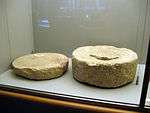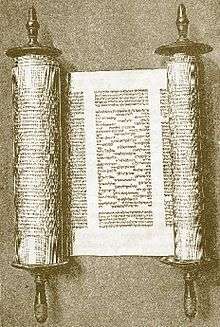Ki Teitzei

Ki Teitzei, Ki Tetzei, Ki Tetse, Ki Thetze, Ki Tese, Ki Tetzey, or Ki Seitzei (כִּי־תֵצֵא — Hebrew for "when you go," the first words in the parashah) is the 49th weekly Torah portion (פָּרָשָׁה, parashah) in the annual Jewish cycle of Torah reading and the sixth in the Book of Deuteronomy. It constitutes Deuteronomy 21:10–25:19. The parashah sets out a series of miscellaneous laws, mostly governing civil and domestic life, including ordinances regarding a beautiful captive of war, inheritance among the sons of two wives, a wayward son, the corpse of an executed person, found property, coming upon another in distress, rooftop safety, prohibited mixtures, sexual offenses, membership in the congregation, camp hygiene, runaway slaves, prostitution, usury, vows, gleaning, kidnapping, repossession, prompt payment of wages, vicarious liability, flogging, treatment of domestic animals, levirate marriage (יִבּוּם, yibbum), weights and measures, and wiping out the memory of Amalek.
The parashah is made up of 5,856 Hebrew letters, 1,582 Hebrew words, 110 verses, and 213 lines in a Torah Scroll (סֵפֶר תּוֹרָה, Sefer Torah).[1] Jews generally read the parashah in August or September.[2] Jews also read the part of the parashah about Amalek, Deuteronomy 25:17–19, as the concluding (מפטיר, maftir) reading on Shabbat Zachor, the special Sabbath immediately before Purim, which commemorates the story of Esther and the Jewish people’s victory over Haman’s plan to kill the Jews, told in the book of Esther.[3] Esther 3:1 identifies Haman as an Agagite, and thus a descendant of Amalek. Numbers 24:7 identifies the Agagites with the Amalekites. A Midrash says that between King Agag’s capture by Saul and his killing by Samuel, Agag fathered a child, from whom Haman in turn descended.[4]
Readings
In traditional Sabbath Torah reading, the parashah is divided into seven readings, or עליות, aliyot. In the Masoretic Text of the Tanakh (Hebrew Bible), Parashah Ki Teitzei has two "open portion" (פתוחה, petuchah) divisions (roughly equivalent to paragraphs, often abbreviated with the Hebrew letter פ (peh)). Parashah Ki Teitzei has several further subdivisions, called "closed portions" (סתומה, setumah) (abbreviated with the Hebrew letter ס (samekh)) within the first open portion (פתוחה, petuchah). The long first open portion (פתוחה, petuchah) spans nearly the entire parashah, except for the concluding maftir (מפטיר) reading. The short second open portion (פתוחה, petuchah) coincides with maftir (מפטיר) reading. Thus the parashah is nearly one complete whole. Closed portion (סתומה, setumah) divisions divide all of the readings (עליות, aliyot), often setting apart separate laws.[5]
First reading — Deuteronomy 21:10–21
In the first reading (עליה, aliyah), Moses directed the Israelites that when they took captives in war, and an Israelite saw among the captives a beautiful woman whom he wanted to marry, the Israelite was to bring her into his house and have her trim her hair, pare her nails, discard her captive’s garb, and spend a month lamenting her parents.[6] Thereafter, the Israelite could take her as his wife.[7] But if he should find that he no longer wanted her, he had to release her outright, and not sell her as a slave.[8] A closed portion (סתומה, setumah) ends here.[9]
In the continuation of the reading, Moses instructed that if a man had two wives, one loved and one unloved, and both bore him sons, but the unloved one bore him his firstborn son, then when he willed his property to his sons, he could not treat the son of the loved wife as firstborn in disregard of the older son of the unloved wife; rather, he was required to accept the firstborn, the son of the unloved one, and allot to him his birthright of a double portion of all that he possessed.[10] A closed portion (סתומה, setumah) ends here.[11]
In the continuation of the reading, Moses instructed that if a couple had a wayward and defiant son, who did not obey his father or mother even after they disciplined him, then they were to bring him to the elders of his town and publicly declare their son to be disloyal, defiant, heedless, a glutton, and a drunkard.[12] The men of his town were then to stone him to death.[13] The first reading (עליה, aliyah) and a closed portion (סתומה, setumah) end here.[14]
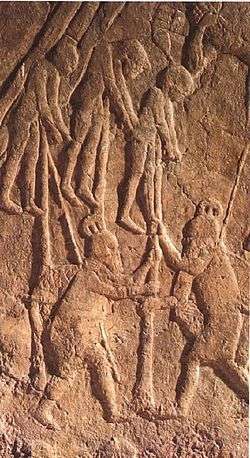
Second reading — Deuteronomy 21:22–22:7
In the second reading (עליה, aliyah), Moses instructed that if the community executed a man for a capital offense and impaled him on a stake, they were not to let his corpse remain on the stake overnight, but were to bury him the same day, for an impaled body affronted God.[15] A closed portion (סתומה, setumah) ends here with the end of the chapter.[14]
In the continuation of the reading, Moses instructed that if one found another’s lost ox, sheep, donkey, garment, or any other lost thing, then the finder could not ignore it, but was required to take it back to its owner.[16] If the owner did not live near the finder or the finder did not know who the owner was, then the finder was to bring the thing home and keep it until the owner claimed it.[17] A closed portion (סתומה, setumah) ends here.[18]
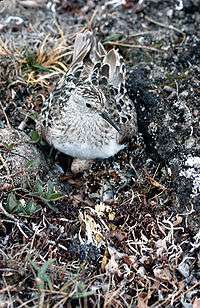
In the continuation of the reading, Moses instructed that if one came upon another’s donkey or ox fallen on the road, then one could not ignore it, but was required to help the owner to raise it.[19] A closed portion (סתומה, setumah) ends here.[20]
In the continuation of the reading, Moses instructed that a woman was not to put on man’s apparel, nor a man wear woman’s clothing.[21] Another closed portion (סתומה, setumah) ends here.[20]
And as the reading continues, Moses instructed that if one came upon a bird’s nest with the mother bird sitting over fledglings or eggs, then one could not take the mother together with her young, but was required to let the mother go and take only the young.[22] The second reading (עליה, aliyah) and a closed portion (סתומה, setumah) end here.[23]
Third reading — Deuteronomy 22:8–23:7
In the third reading (עליה, aliyah), Moses taught that when one built a new house, one had to make a parapet for the roof, so that no one should fall from it.[24] One was not to sow a vineyard with a second kind of seed, nor use the yield of such a vineyard.[25] A closed portion (סתומה, setumah) ends here.[23]
In the continuation of the reading, Moses instructed that one was not to plow with an ox and a donkey together.[26] One was not to wear cloth combining wool and linen.[27] A closed portion (סתומה, setumah) ends here.[23]
In the continuation of the reading, Moses instructed that one was to make tassels (tzitzit) on the four corners of the garment with which one covered oneself.[28] Another closed portion (סתומה, setumah) ends here.[29]
As the reading continues, Moses instructed that if a man married a woman, cohabited with her, took an aversion to her, and falsely charged her with not having been a virgin at the time of the marriage, then the woman’s parents were to produce the cloth with evidence of the woman’s virginity before the town elders at the town gate.[30] The elders were then to have the man flogged and fine him 100 shekels of silver to be paid to the woman’s father.[31] The woman was to remain the man’s wife, and he was never to have the right to divorce her.[32] A closed portion (סתומה, setumah) ends here.[33]
In the continuation of the reading, Moses instructed that if the elders found that woman had not been a virgin, then the woman was to be brought to the entrance of her father’s house and stoned to death by the men of her town.[34] A closed portion (סתומה, setumah) ends here.[33]
In the continuation of the reading, Moses instructed that if a man was found lying with another man’s wife, both the man and the woman with whom he lay were to die.[35] Another closed portion (סתומה, setumah) ends here.[33]
As the reading continues, Moses instructed that if, in a city, a man lay with a virgin who was engaged to a man, then the authorities were to take the two of them to the town gate and stone them to death — the girl because she did not cry for help, and the man because he violated another man’s wife.[36] A closed portion (סתומה, setumah) ends here.[37]
In the continuation of the reading, Moses instructed that if the man lay with the girl by force in the open country, only the man was to die, for there was no one to save her.[38] Another closed portion (סתומה, setumah) ends here.[37]
In the continuation of the reading, Moses instructed that if a man seized a virgin who was not engaged and lay with her, then the man was to pay the girl’s father 50 shekels of silver, she was to become the man’s wife, and he was never to have the right to divorce her.[39] A closed portion (סתומה, setumah) ends here with the end of the chapter.[37]
As the reading continues in chapter 23, Moses instructed that no man could marry his father’s former wife.[40] A closed portion (סתומה, setumah) ends here.[41]
In the continuation of the reading, Moses taught that God’s congregation could not admit into membership anyone whose testes were crushed or whose member was cut off.[42] A closed portion (סתומה, setumah) ends here.[41]
In the continuation of the reading, Moses taught that God’s congregation could not admit into membership anyone misbegotten or anyone descended within ten generations from one misbegotten.[43] A closed portion (סתומה, setumah) ends here.[41]
And as the reading continues, Moses instructed that God’s congregation could not admit into membership any Ammonite or Moabite, or anyone descended within ten generations from an Ammonite or Moabite.[44] As long as they lived, Israelites were not to concern themselves with the welfare or benefit of Ammonites or Moabites, because they did not meet the Israelites with food and water after the Israelites left Egypt, and because they hired Balaam to curse the Israelites — but God refused to heed Balaam, turning his curse into a blessing.[45] The third reading (עליה, aliyah) and a closed portion (סתומה, setumah) end here.[46]
Fourth reading — Deuteronomy 23:8–24
In the fourth reading (עליה, aliyah), Moses told the Israelites not to abhor the Edomites, for they were kinsman, nor Egyptians, for the Israelites were strangers in Egypt.[47] Great grandchildren of Edomites or Egyptians could be admitted into the congregation.[48] A closed portion (סתומה, setumah) ends here.[46]
In the continuation of the reading, Moses taught that any Israelite rendered unclean by a nocturnal emission had to leave the Israelites military camp, bathe in water toward evening, and reenter the camp at sundown.[49] The Israelites were to designate an area outside the camp where they might relieve themselves, and to carry a spike to dig a hole and cover up their excrement.[50] As God moved about in their camp to protect them, the Israelites were to keep their camp holy.[51] A closed portion (סתומה, setumah) ends here.[52]
In the continuation of the reading, Moses taught that if a slave sought refuge with the Israelites, the Israelites were not to turn the slave over to the slave’s master, but were to let the former slave live in any place the former slave might choose and not ill-treat the former slave.[53] A closed portion (סתומה, setumah) ends here.[52]
In the continuation of the reading, Moses forbade the Israelites to act as harlots, sodomites, or cult prostitutes, and from bringing the wages of prostitution into the house of God in fulfillment of any vow.[54] A closed portion (סתומה, setumah) ends here.[52]

In the continuation of the reading, Moses forbade the Israelites to charge interest on loans to their countrymen, but they could charge interest on loans to foreigners.[55] A closed portion (סתומה, setumah) ends here.[56]
In the continuation of the reading, Moses required the Israelites promptly to fulfill vows to God, but they incurred no guilt if they refrained from vowing.[57] The fourth reading (עליה, aliyah) and a closed portion (סתומה, setumah) end here.[58]
Fifth reading — Deuteronomy 23:25–24:4
In the fifth reading (עליה, aliyah), Moses allowed a visiting Israelite to enter another’s vineyard and eat grapes until full, but the visitor was forbidden to put any in a vessel.[59] A closed portion (סתומה, setumah) ends here.[58]
As the reading continues, Moses allowed a visiting Israelite to enter another’s field of standing grain and pluck ears by hand, but the visitor was forbidden to cut the neighbor’s grain with a sickle.[60] A closed portion (סתומה, setumah) ends here with the end of the chapter.[58]
As the reading continues in chapter 24, Moses instructed that a divorced woman who remarried and then lost her second husband to divorce or death could not remarry her first husband.[61] The fifth reading (עליה, aliyah) and a closed portion (סתומה, setumah) end here.[62]
Sixth reading — Deuteronomy 24:5–13
In the sixth reading (עליה, aliyah), Moses exempted a newlywed man from army duty for one year, so as to give happiness to his wife.[63] Israelites were forbidden to take a handmill or an upper millstone in pawn, for that would be taking someone’s livelihood.[64] A closed portion (סתומה, setumah) ends here.[65]
In the continuation of the reading, Moses taught that one found to have kidnapped a fellow Israelite was to die.[66] A closed portion (סתומה, setumah) ends here.[65]
In the continuation of the reading, Moses taught that in cases of a skin affection, Israelites were to do exactly as the priests instructed, remembering that God afflicted and then healed Miriam’s skin after the Israelites left Egypt.[67] A closed portion (סתומה, setumah) ends here.[65]
In the continuation of the reading, Moses forbade an Israelite who lent to a fellow Israelite to enter the borrower’s house to seize a pledge, and required the lender to remain outside while the borrower brought the pledge out to the lender.[68] If the borrower was needy, the lender was forbidden to sleep in the pledge, but had to return the pledge to the borrower at sundown, so that the borrower might sleep in the cloth and bless the lender before God.[69] The sixth reading (עליה, aliyah) and a closed portion (סתומה, setumah) end here.[70]
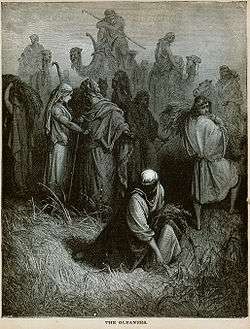
Seventh reading — Deuteronomy 24:14–25:19
In the seventh reading (עליה, aliyah), Moses forbade the Israelites to abuse a needy and destitute laborer, whether an Israelite or a stranger, and were required to pay the laborer’s wages on the same day, before the sun set, as the laborer would depend on the wages.[71] A closed portion (סתומה, setumah) ends here.[72]
In the continuation of the reading, Moses taught that parents were not to be put to death for children, nor were children to be put to death for parents; a person was to be put to death only for the person’s own crime.[73] A closed portion (סתומה, setumah) ends here.[74]
_-_The_Olive_Trees_(1889).jpg)
In the continuation of the reading, Moses forbade the Israelites to subvert the rights of the proselyte or the orphan, and forbade the Israelites to take a widow’s garment in pawn, remembering that they were slaves in Egypt and that God redeemed them.[75] A closed portion (סתומה, setumah) ends here.[74]
In the continuation of the reading, Moses instructed that when Israelites reaped the harvest in their fields and overlooked a sheaf, they were not to turn back to get it, but were to leave it to the proselyte, the orphan, and the widow.[76] A closed portion (סתומה, setumah) ends here.[74]
In the continuation of the reading, Moses instructed that when Israelites beat down the fruit of their olive trees or gathered the grapes of their vineyards, they were not to go over them again, but were leave what remained for the proselyte, the orphan, and the widow, remembering that they were slaves in Egypt.[77] A closed portion (סתומה, setumah) ends here with the end of the chapter.[78]
As the reading continues in chapter 25, Moses instructed that when one was to be flogged, the judge was to have the guilty one lie down and be whipped in his presence, as warranted but with no more than 40 lashes, so that the guilty one would not be degraded.[79] Israelites were forbidden to muzzle an ox while it was threshing.[80] A closed portion (סתומה, setumah) ends here.[81]
In the continuation of the reading, Moses instructed that when brothers dwelt together and one of them died leaving no son, the surviving brother was to marry the wife of the deceased and perform the levir’s duty, and the first son that she bore was to be accounted to the dead brother, that his name might survive.[82] But if the surviving brother did not want to marry his brother’s widow, then the widow was to appear before the elders at the town gate and declare that the brother refused to perform the levir’s duty, the elders were to talk to him, and if he insisted, the widow was to go up to him before the elders, pull the sandal off his foot, spit in his face, and declare: "Thus shall be done to the man who will not build up his brother’s house!"[83] They would then call him "the family of the unsandaled one."[84] A closed portion (סתומה, setumah) ends here.[85]
In the continuation of the reading, Moses instructed that if two men fought with each other, and to save her husband the wife of one seized the other man’s genitals, then her hand was to be cut off.[86] A closed portion (סתומה, setumah) ends here.[85]
In the continuation of the reading, Moses forbade Israelites to have alternate weights or measures, larger and smaller, and required them to have completely honest weights and measures.[87] The long first open portion (פתוחה, petuchah) ends here.[88]
In the maftir (מפטיר) reading of Deuteronomy 25:17–19 that concludes the parashah,[89] Moses enjoined the Israelites to remember what the Amalekites did to them on their journey, after they left Egypt, surprising them and cutting down all the stragglers at their rear.[90] The Israelites were enjoined never to forget to blot out the memory of Amalek from under heaven.[91] The second open portion (פתוחה, petuchah) ends here with the end of the parashah.[92]
Readings according to the triennial cycle
Jews who read the Torah according to the triennial cycle of Torah reading read the parashah according to the following schedule:[93]
| Year 1 | Year 2 | Year 3 | |
|---|---|---|---|
| 2016–2017, 2019–2020 . . . | 2017–2018, 2020–2021 . . . | 2018–2019, 2021–2022 . . . | |
| Reading | 21:10–23:7 | 23:8–24:13 | 24:14–25:19 |
| 1 | 21:10–14 | 23:8–12 | 24:14–16 |
| 2 | 21:15–17 | 23:13–15 | 24:17–19 |
| 3 | 21:18–21 | 23:16–19 | 24:20–22 |
| 4 | 21:22–22:7 | 23:20–24 | 25:1–4 |
| 5 | 22:8–12 | 23:25–24:4 | 25:5–10 |
| 6 | 22:13–29 | 24:5–9 | 25:11–16 |
| 7 | 23:1–7 | 24:10–13 | 25:17–19 |
| Maftir | 23:4–7 | 24:10–13 | 25:17–19 |
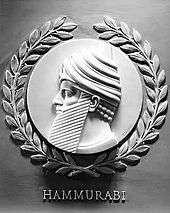
In ancient parallels
The parashah has parallels in these ancient sources:
Deuteronomy chapter 25
Presaging the injunction of Deuteronomy 25:13–16 for honest weights and measures, the Code of Hammurabi decreed that if merchants used a light scale to measure the grain or the silver that they lent and a heavy scale to measure the grain or the silver that they collected, then they were to forfeit their investment.[94]
In translation
While many English translations refer to "the third generation" in Deuteronomy 23:8, some versions refer to "grandchildren" (e.g. God's Word Translation, International Standard Version and The Living Bible) whereas other versions refer to "great-grandchildren" (e.g. Contemporary English Version, New Century Version and New International Reader's Version).[95]
In inner-biblical interpretation
The parashah has parallels or is discussed in these Biblical sources:[96]
Deuteronomy chapters 12–26
Professor Benjamin Sommer of the Jewish Theological Seminary of America argued that Deuteronomy 12–26 borrowed whole sections from the earlier text of Exodus 21–23.[97]
Deuteronomy chapter 21
The "double portion" to be inherited by the firstborn son is literally a "double mouthful".[98] Jacob had said to Joseph in his last testament, "I give you one portion more than your brothers".[99]
The punishment of being stoned outside the city, prescribed in Deuteronomy 21:21 for a stubborn and rebellious son, was also the punishment prescribed for blaspheming the name of the Lord in Leviticus 24:16,23. The Jamieson-Fausset-Brown Bible Commentary suggests that "parents are considered God's representatives and invested with a portion of his authority over their children"[100] and therefore refusal to obey the voice of one's father or mother, when they have chastened one, is akin to refusal to honor the name of God. Proverbs 23:20 uses the same words, "a glutton and a drunkard", as Deuteronomy 21:20, also linked in the succeeding verses of Proverbs to the need for obedience to and respect for one's parents: "Listen to your father who begot you, and do not despise your mother when she is old" (Proverbs 23:22).
Deuteronomy chapter 22
The instruction in Exodus 23:5 that parallels Deuteronomy 22:4 states that the duty to restore a fallen donkey or ox applies to one's enemy's animals as well as to one's brother's.
Deuteronomy chapter 23
The first biblical mention of the Moabites and the Ammonites (or the people of Ammon) is in Genesis 19:37–38. It is stated there that the Ammonites were descended from Ben-Ammi, a son of Lot through incest with his younger daughter. Bén'ámmî literally means "son of my people". After the destruction of Sodom and Gomorrah, the daughters of Lot had sexual relations with their father, resulting in Ammon and his half brother, Moab, being conceived. This narrative was previously considered literal fact, but is now generally interpreted as recording a gross popular irony by which the Israelites expressed their loathing of the Moabites and Ammonites.[101] However, according to the same source, doubts remain as to whether the Israelites would have been willing to attribute such an irony to Lot himself. Deuteronomy 2:27–30 records the Israelites' request for safe passage and supplies through the land of the Moabites and the Moabites' refusal to "meet them with bread and water" is recalled in Deuteronomy 23:4.
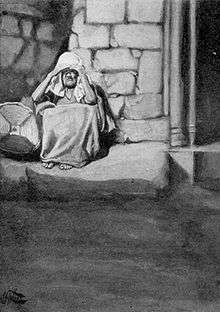
Their exclusion from the Israelite congregation, "to their tenth generation, shall they not enter into the congregation of the Lord for ever",[102] is best understood to mean not only to the tenth generation, but for ever; and this law was understood as in force in Nehemiah's time, which was more than ten generations from the occupation of Canaan.[103] The text of Deuteronomy 23:4 was read in Nehemiah 13:1–2 when the post-exilic temple was rededicated.
Deuteronomy chapter 24
The Hebrew Bible reports skin disease (צָּרַעַת, tzara’at) and a person affected by skin disease (מְּצֹרָע, metzora) at several places, often (and sometimes incorrectly) translated as "leprosy" and "a leper." In Exodus 4:6, to help Moses to convince others that God had sent him, God instructed Moses to put his hand into his bosom, and when he took it out, his hand was "leprous (מְצֹרַעַת, m’tzora’at), as white as snow." In Leviticus 13–14, the Torah sets out regulations for skin disease (צָרַעַת, tzara’at) and a person affected by skin disease (מְּצֹרָע, metzora). In Numbers 12:10 after Miriam spoke against Moses, God’s cloud removed from the Tent of Meeting and "Miriam was leprous (מְצֹרַעַת, m’tzora’at), as white as snow." In the current parashah, Moses warned the Israelites in the case of skin disease (צָּרַעַת, tzara’at) diligently to observe all that the priests would teach them, remembering what God did to Miriam (Deuteronomy 24:8–9). In 2 Kings 5:1–19, part of the haftarah for parashah Tazria, the prophet Elisha cures Naaman, the commander of the army of the king of Aram, who was a "leper" (מְּצֹרָע, metzora). In 2 Kings 7:3–20, part of the haftarah for parashah Metzora, the story is told of four "leprous men" (מְצֹרָעִים, m’tzora’im) at the gate during the Arameans’ siege of Samaria. And in 2 Chronicles 26:19, after King Uzziah tried to burn incense in the Temple in Jerusalem, "leprosy (צָּרַעַת, tzara’at) broke forth on his forehead."
Deuteronomy 24:14–15 and 17–22 admonish the Israelites not to wrong the stranger, for "you shall remember that you were a bondman in Egypt." (See also Exodus 22:20; 23:9; Leviticus 19:33–34; Deuteronomy 1:16; 10:17–19 and 27:19.) Similarly, in Amos 3:1, the 8th century BCE prophet Amos anchored his pronouncements in the covenant community's Exodus history, saying, "Hear this word that the Lord has spoken against you, O children of Israel, against the whole family that I brought up out of the land of Egypt."[104]
The prophet Isaiah used the practice of leaving olives on the boughs and grapes in the vineyard for gleanings (Deuteronomy 24:20–21) as a sign of hope for Israel when he forecast the nation's downfall:
- "In that day it shall come to pass that the glory of Jacob will wane ... yet gleaning grapes will be left in it, like the shaking of an olive tree, two or three olives at the top of the uppermost bough, four or five in its most fruitful branches." (Isaiah 12:10)
Deuteronomy chapter 25
The duty of a brother pursuant to Deuteronomy 25:5–10 to perform a Levirate marriage (יִבּוּם, yibbum) with the wife of a deceased brother is reflected in the stories of Tamar in Genesis 38:6–11 and Ruth in Ruth 1:5–11; 3:12; and 4:1–12.
The Israelites' victory over the Amalekites and the role of Moses, supported by Aaron and Hur in directing the battle's outcome, was recorded in Exodus 17:8–16, but the Exodus narrative does not mention the Amalekites' tactics of attacking the "faint and weary" at the rear of the Israelites' convoy (Deuteronomy 25:17). At Moses' direction it was also recorded in another ancient text, possibly the Book of the Wars of the Lord, "I will utterly blot out the remembrance of Amalek from under heaven." (Exodus 17:14).
In 1 Samuel 15:1–3, the prophet Samuel conveys the command of God to King Saul to "punish Amalek for what he did to Israel". Saul "utterly destroyed" the Amalekites; initially he spared Agag their king, but Samuel killed him later.[105]

In early nonrabbinic interpretation
The parashah has parallels or is discussed in these early nonrabbinic sources:[106]
Deuteronomy chapter 23
The Damascus Document of the Qumran sectarians prohibited non-cash transactions with Jews who were not members of the sect. Professor Lawrence Schiffman of New York University read this regulation as an attempt to avoid violating prohibitions on charging interest to one’s fellow Jew in Exodus 22:25; Leviticus 25:36–37; and Deuteronomy 23:19–20. Apparently, the Qumran sect viewed prevailing methods of conducting business through credit as violating those laws.[107]

Philo read Deuteronomy 23:22 to instruct us to be prompt in our gratitude to God. Philo cited Cain as an example of a "self-loving man" who (in Genesis 4:3) showed his gratitude to God too slowly. Philo taught that we should hurry to please God without delay. Thus Deuteronomy 23:22 enjoins, "If you vow a vow, you shall not delay to perform it." Philo explained that a vow is a request to God for good things, and Deuteronomy 23:22 thus enjoins that when one has received them, one must offer gratitude to God as soon as possible. Philo divided those who fail to do so into three types: (1) those who forget the benefits that they have received, (2) those who from an excessive conceit look upon themselves and not God as the authors of what they receive, and (3) those who realize that God caused what they received, but still say that they deserved it, because they are worthy to receive God’s favor. Philo taught that Scripture opposes all three. Philo taught that Deuteronomy 8:12–14 replies to the first group who forget, "Take care, lest when you have eaten and are filled, and when you have built fine houses and inhabited them, and when your flocks and your herds have increased, and when your silver and gold, and all that you possess is multiplied, you be lifted up in your heart, and forget the Lord your God." Philo taught that one does not forget God when one remembers one’s own nothingness and God’s exceeding greatness. Philo interpreted Deuteronomy 8:17 to reprove those who look upon themselves as the cause of what they have received, telling them: "Say not my own might, or the strength of my right hand has acquired me all this power, but remember always the Lord your God, who gives you the might to acquire power." And Philo read Deuteronomy 9:4–5 to address those who think that they deserve what they have received when it says, "You do not enter into this land to possess it because of your righteousness, or because of the holiness of your heart; but, in the first place, because of the iniquity of these nations, since God has brought on them the destruction of wickedness; and in the second place, that He may establish the covenant that He swore to our Fathers." Philo interpreted the term "covenant" figuratively to mean God’s graces. Thus Philo concluded that if we discard forgetfulness, ingratitude, and self-love, we shall not longer through our delay miss attaining the genuine worship of God, but we shall meet God, having prepared ourselves to do the things that God commands us.[108]
A Dead Sea Scroll manuscript from Qumran Cave 4, probably dated to the turn of the common era, deduced from Deuteronomy 23:25–26 that a poor person could eat ears of corn in the field of another person, but was not allowed to take any home. On a threshing-floor, however, the poor person could both eat and gather provisions for his family.[109]
In classical rabbinic interpretation
The parashah is discussed in these rabbinic sources from the era of the Mishnah and the Talmud:[110]
Deuteronomy chapter 21
Deuteronomy 21:10–14 — the beautiful captive
The Gemara taught that Deuteronomy 21:10–14 provided the law of taking a beautiful captive only as an allowance for human passions. The Rabbis taught in a Baraita that taking a beautiful captive according to the strictures of Deuteronomy 21:10–14 was better than taking beautiful captives without restriction, just as it was better for Jews to eat the meat of a ritually slaughtered ill animal than to eat the meat of an ill animal that had died on its own. The Rabbis interpreted the words "and you see among the captives" in Deuteronomy 21:11 to mean that the provisions applied only if the soldier set his eye upon the woman when taking her captive, not later. They interpreted the words "a woman" in Deuteronomy 21:11 to mean that the provisions applied even to a woman who was married before having been taken captive. They interpreted the words "and you have a desire" in Deuteronomy 21:11 to mean that the provisions applied even if the woman was not beautiful. They interpreted the word "her" in Deuteronomy 21:11 to mean that the provisions allowed him to take her alone, not her and her companion. They interpreted the words "and you shall take" in Deuteronomy 21:11 to mean that the soldier could have marital rights over her. They interpreted the words "to you to wife" in Deuteronomy 21:11 to mean that the soldier could not take two women, one for himself and another for his father, or one for himself and another for his son. And they interpreted the words "then you shall bring her home" in Deuteronomy 21:12 to mean that the soldier could not molest her on the battlefield. Rav said that Deuteronomy 21:10–14 permitted a priest to take a beautiful captive, while Samuel maintained that it was forbidden.[111]
A Baraita taught that the words of Deuteronomy 21:10, "And you carry them away captive," were meant to include Canaanites who lived outside the land of Israel, teaching that if they repented, they would be accepted.[112]
The Gemara taught that the procedure of Deuteronomy 21:12–13 applied only when the captive did not accept the commandments, for if she accepted the commandments, then she could be immersed in a ritual bath (מִקְוֶה, mikveh), and she and the soldier could marry immediately.[113] Rabbi Eliezer interpreted the words "and she shall shave her head and do her nails" in Deuteronomy 21:12 to mean that she was to cut her nails, but Rabbi Akiva interpreted the words to mean that she was to let them grow. Rabbi Eliezer reasoned that Deuteronomy 21:12 specified an act with respect to the head and an act with respect to the nails, and as the former meant removal, so should the latter. Rabbi Akiva reasoned that Deuteronomy 21:12 specified disfigurement for the head, so it must mean disfigurement for the nails, as well.[114]
Rabbi Eliezer interpreted the words "bewail her father and her mother" in Deuteronomy 21:13 to mean her actual father and mother. But Rabbi Akiva interpreted the words to mean idolatry, citing Jeremiah 2:27. A Baraita taught that "a full month" meant 30 days. But Rabbi Simeon ben Eleazar interpreted Deuteronomy 21:13 to call for 90 days — 30 days for "month," 30 days for "full," and 30 days for "and after that." Rabina said that one could say that "month" meant 30 days, "full" meant 30 days, and "and after that" meant an equal number (30 plus 30) again, for a total of 120 days.[115]
Deuteronomy 21:15–17 — inheritance among the sons of two wives
The Mishnah and the Talmud interpreted the laws of the firstborn’s inheritance in Deuteronomy 21:15–17 in Mishnah Bava Batra 8:4–5,[116] Babylonian Talmud Bava Batra 122b–34a,[117] Mishnah Bekhorot 8:9,[118] and Babylonian Talmud Bekhorot 51b–52b.[119] The Mishnah interpreted Deuteronomy 21:17 to teach that a son and a daughter have equal inheritance rights, except that a firstborn son takes a double portion in his father’s estate but does not take a double portion in his mother’s estate.[120] The Mishnah taught that they disregarded a father who said, "My firstborn son shall not inherit a double portion," or "My son shall not inherit with his brothers," because the father’s stipulation would be contrary to Deuteronomy 21:17. But a father could distribute his property as gifts during his lifetime so that one son received more than another, or so that the firstborn received merely an equal share, so long as the father did not try to make these conveyances as an inheritance upon his death.[121]

The Gemara recounted a discussion regarding the right of the firstborn in Deuteronomy 21:17. Once Rabbi Jannai was walking, leaning on the shoulder of Rabbi Simlai his attendant, and Rabbi Judah the Prince came to meet them. Rabbi Judah the Prince asked Rabbi Jannai what the Scriptural basis was for the proposition that a son takes precedence over a daughter in the inheritance of a mother's estate. Rabbi Jannai replied that the plural use of the term "tribes" in the discussion of the inheritance of the daughters of Zelophehad in Numbers 36:8 indicates that the mother's tribe is to be compared to the father's tribe, and as in the case of the father's tribe, a son takes precedence over a daughter, so in the case of the mother's tribe, a son should take precedence over a daughter. Rabbi Judah the Prince challenged Rabbi Jannai, saying that if it this were so, one could say that as in the case of the father's tribe, a firstborn takes a double portion, so in the case of the mother's tribe would a firstborn take a double portion. Rabbi Jannai dismissed the remark of Rabbi Judah the Prince. The Gemara then inquired why it is true that a firstborn son takes a double share in his father's estate but not his mother's. Abaye replied that Deuteronomy 21:17 says, "of all that he [the father] has," implying all that "he" (the father) has and not all that "she" (the mother) has. The Gemara asked whether the proposition that a firstborn son takes a double portion only in the estate of his father might apply only in the case where a bachelor married a widow (who had children from her first marriage, and thus the father's firstborn son was not that of the mother). And thus where a bachelor married a virgin (so that the firstborn son of the father would also be the firstborn son of the mother) might the firstborn son also take a double portion in his mother’s estate? Rav Nahman bar Isaac replied that Deuteronomy 21:17 says, "for he [the firstborn son] is the first-fruits of his [the father’s] strength," from which we can infer that the law applies to the first fruits of the father’s strength and not the first-fruits of the mother’s strength. The Gemara replied that Deuteronomy 21:17 teaches that though a son was born after a miscarriage (and thus did not "open the womb" and is not regarded as a firstborn son for purposes of "sanctification to the Lord" and "redemption from the priest" in Exodus 13:2) he is nonetheless regarded as the firstborn son for purposes of inheritance. Deuteronomy 21:17 thus implies that only the son for whom the father's heart grieves is included in the law, but a miscarriage, for which the father's heart does not grieve, is excluded. (And thus, since Deuteronomy 21:17 is necessary for this deduction, it could not have been meant for the proposition that the law applies to the first fruits of the father’s strength and not of the mother’s strength.) But then the Gemara reasoned that if Deuteronomy 21:17 is necessary for excluding miscarriages, then Deuteronomy 21:17 should have read, "for he is the first-fruits of strength," but Deuteronomy 21:17 in fact says, "his strength." Thus one may deduce two laws from Deuteronomy 21:17. But the Gemara objected further that still that the words of Deuteronomy 21:17, "the first-fruits of his [the father’s] strength," not her strength, might apply only to the case of a widower (who had children from his first wife) who married a virgin (since the first son from the second marriage would be only the wife's firstborn, not the husband’s). But where a bachelor married a virgin (and thus the son would be the firstborn of both the father and the mother), the firstborn son might take a double portion also in his mother’s estate. But Rava concluded that Deuteronomy 21:17 states, "the right of the firstborn is his [the father’s]," and this indicates that the right of the firstborn applies to a man’s estate and not to a woman’s.[122]
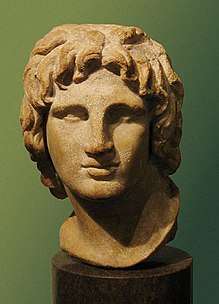
A Midrash told that the Ishmaelites came before Alexander the Great to dispute the birthright with Israel, accompanied by the Canaanites and the Egyptians. The Ishmaelites based their claim on Deuteronomy 21:17, "But he shall acknowledge the firstborn, the son of the hated," and Ishmael was the firstborn. Gebiah the son of Kosem representing the Jews, asked Alexander whether a man could not do as he wished to his sons. When Alexander replied that a man could, Gebiah quoted Genesis 25:5, "And Abraham gave all that he had to Isaac." The Ishmaelites asked where the deed of gift to his other sons was. Gebiah replied by quoting Genesis 25:7, "But to the sons of the concubines, whom Abraham had, Abraham gave gifts." Thereupon the Ishmaelites departed in shame.[123]
Deuteronomy 21:18–21 — the wayward son
Chapter 8 of tractate Sanhedrin in the Mishnah and Babylonian Talmud interpreted the laws of the wayward and rebellious son (בֵּן סוֹרֵר וּמוֹרֶה, ben sorer umoreh) in Deuteronomy 21:18–21.[124] A Baraita taught that there never was a "stubborn and rebellious son" and never would be, and that Deuteronomy 21:18–21 was written merely that we might study it and receive reward for the studying. But Rabbi Jonathan said that he saw a stubborn and rebellious son and sat on his grave.[125]
The Mishnah interpreted the words "a son" in Deuteronomy 21:18 to teach that provision applied to "a son," but not a daughter, and to "a son," but not a full-grown man. The Mishnah exempted a minor, because minors did not come within the scope of the commandments. And the Mishnah deduced that a boy became liable to being considered "a stubborn and rebellious son" from the time that he grew two genital pubic hairs until his pubic hair grew around his genitalia.[126] Rav Judah taught in Rav’s name that Deuteronomy 21:18 implied that the son had to be nearly a man.[127]
The Mishnah interpreted the words of Deuteronomy 21:20 to exclude from designation as a "stubborn and rebellious son" a boy who had a parent with any of a number of physical characteristics. The Mishnah interpreted the words "then his father and his mother shall lay hold on him" to exclude a boy if one of his parents had a hand or fingers cut off. The Mishnah interpreted the words "and bring him out" to exclude a boy who had a lame parent. The Mishnah interpreted the words "and they shall say" to exclude a boy who had a parent who could not speak. The Mishnah interpreted the words "this our son" to exclude a boy who had a blind parent. The Mishnah interpreted the words "he will not obey our voice" to exclude a boy who had a deaf parent.[128]
Deuteronomy chapter 22
The first two chapters of tractate Bava Metzia in the Mishnah, Tosefta, and Babylonian Talmud interpreted the laws of lost property in Deuteronomy 22:1–3.[129] The Mishnah read the reference to "your brother’s ox or his sheep" in Deuteronomy 22:1 to apply to any domestic animal.[130] The Mishnah read the emphatic words of Deuteronomy 22:1, "you shall surely return them," repeating the verb "return" in the Hebrew, to teach that Deuteronomy 22:1 required a person to return a neighbor’s animal again and again, even if the animal kept running away four or five times.[131] And Rava taught that Deuteronomy 22:1 required a person to return the animal even a hundred times.[132] If one found an identifiable item and the identity of the owner was unknown, the Mishnah taught that the finder was required to announce it. Rabbi Meir taught that the finder was obliged to announce it until his neighbors could know of it. Rabbi Judah maintained that the finder had to announce it until three festivals had passed plus an additional seven days after the last festival, allowing three days for going home, three days for returning, and one day for announcing.[133]
A Baraita cited among affirmative precepts not limited to time those regarding returning lost property in Deuteronomy 22:1–3, the dismissal of the mother bird in Deuteronomy 22:6–7, and the building of fences around accessible roofs in Deuteronomy 22:8.[134]
Rava taught that Deuteronomy 22:3, “And so shall you do with every lost item of your brother,” serves to include an obligation to protect one’s brother from the loss of his land. Rav Ḥananya replied that a Baraita taught that if one saw water that is flowing and coming to inundate another’s field, one must establish a barrier before the water in order to preserve the other’s field.[132]
The Gemara read the emphatic words of Deuteronomy 22:4, "you shall surely help . . . to lift," repeating the verb in the Hebrew, to teach that Deuteronomy 22:4 required a person to lift a neighbor’s animal alone, even if the animal’s owner was too sick or too old to help.[132] Similarly, the Sifre read the emphatic words of Deuteronomy 22:4 to teach that Deuteronomy 22:4 required a person to help lift a neighbor’s animal even if they lifted it, it fell again, and again, even five times.[135]
Chapter 12 of tractate Chullin in the Mishnah and Babylonian Talmud interpreted the laws of sending the mother bird away from the nest (שילוח הקן, shiluach hakein) in Deuteronomy 22:6–7.[136] The Mishnah read Deuteronomy 22:6–7 to require a person to let the mother bird go again and again, even if the mother bird kept coming back to the nest four or five times.[137] And the Gemara taught that Deuteronomy 22:6–7 required a person to let the mother bird go even a hundred times.[132]
.jpg)
Tractate Kilayim in the Mishnah, Tosefta, and Jerusalem Talmud interpreted the laws of separating diverse species in Deuteronomy 22:9–11.[138]
The Mishnah employed the prohibitions of Deuteronomy 22:9, 22:10, and 22:11 to imagine how one could with one action violate up to nine separate commandments. One could (1) plow with an ox and a donkey yoked together (in violation of Deuteronomy 22:10) (2 and 3) that are two animals dedicated to the sanctuary, (4) plowing mixed seeds sown in a vineyard (in violation of Deuteronomy 22:9), (5) during a Sabbatical year (in violation of Leviticus 25:4), (6) on a Festival-day (in violation of, for example, Leviticus 23:7), (7) when the plower is a priest (in violation of Leviticus 21:1) and (8) a Nazirite (in violation of Numbers 6:6) plowing in a contaminated place. Chananya ben Chachinai said that the plower also may have been wearing a garment of wool and linen (in violation of Leviticus 19:19 and Deuteronomy 22:11). They said to him that this would not be in the same category as the other violations. He replied that neither is the Nazirite in the same category as the other violations.[139]
Rabbi Joshua of Siknin taught in the name of Rabbi Levi that the Evil Inclination criticizes four laws as without logical basis, and Scripture uses the expression "statute" (חֹק, chok) in connection with each: the laws of (1) a brother’s wife (in Deuteronomy 25:5–10), (2) mingled kinds (in Leviticus 19:19 and Deuteronomy 22:11), (3) the scapegoat (in Leviticus 16), and (4) the red cow (in Numbers 19).[140]
Leviticus 18:4 calls on the Israelites to obey God’s "statutes" (חֻקִּים, chukim) and "ordinances" (מִּשְׁפָּטִים, mishpatim). The Rabbis in a Baraita taught that the "ordinances" (מִּשְׁפָּטִים, mishpatim) were commandments that logic would have dictated that we follow even had Scripture not commanded them, like the laws concerning idolatry, adultery, bloodshed, robbery, and blasphemy. And "statutes" (חֻקִּים, chukim) were commandments that the Adversary challenges us to violate as beyond reason, like those relating to שַׁעַטְנֵז, shaatnez (in Leviticus 19:19 and Deuteronomy 22:11); חליצה, chalitzah (in Deuteronomy 25:5–10); purification of the person with skin disease, צָּרַעַת, tzara’at (in Leviticus 14), and the scapegoat (in Leviticus 16). So that people do not think these "ordinances" (מִּשְׁפָּטִים, mishpatim) to be empty acts, in Leviticus 18:4, God says, "I am the Lord," indicating that the Lord made these statutes, and we have no right to question them.[141]
Similarly, reading Leviticus 18:4, "My ordinances (מִשְׁפָּטַי, mishpatai) shall you do, and My statutes (חֻקֹּתַי, chukotai) shall you keep," the Sifra distinguished "ordinances" (מִשְׁפָּטִים, mishpatim) from "statutes" (חֻקִּים, chukim). The term "ordinances" (מִשְׁפָּטִים, mishpatim), taught the Sifra, refers to rules that even had they not been written in the Torah, it would have been entirely logical to write them, like laws pertaining to theft, sexual immorality, idolatry, blasphemy and murder. The term "statutes" (חֻקִּים, chukim), taught the Sifra, refers to those rules that the impulse to do evil (יצר הרע, yetzer hara) and the nations of the world try to undermine, like eating pork (prohibited by Leviticus 11:7 and Deuteronomy 14:7–8), wearing wool-linen mixtures (שַׁעַטְנֵז, shatnez, prohibited by Leviticus 19:19 and Deuteronomy 22:11), release from levirate marriage (חליצה, chalitzah, mandated by Deuteronomy 25:5–10), purification of a person affected by skin disease (מְּצֹרָע, metzora, regulated in Leviticus 13–14), and the goat sent off into the wilderness (the scapegoat, regulated in Leviticus 16). In regard to these, taught the Sifra, the Torah says simply that God legislated them and we have no right to raise doubts about them.[142]
Rabbi Eleazar ben Azariah taught that people should not say that they do not want to wear a wool-linen mixture (שַׁעַטְנֵז, shatnez, prohibited by Leviticus 19:19 and Deuteronomy 22:11), eat pork (prohibited by Leviticus 11:7 and Deuteronomy 14:7–8), or be intimate with forbidden partners (prohibited by Leviticus 18 and 20), but rather should say that they would love to, but God has decreed that they not do so. For in Leviticus 20:26, God says, "I have separated you from the nations to be mine." So one should separate from transgression and accept the rule of Heaven.[143]
Chapter 3 of tractate Ketubot in the Mishnah, Tosefta, and Babylonian Talmud interpreted the laws of seducers and rapists in Deuteronomy 22:25–29.[144]
Deuteronomy chapter 23
Interpreting Deuteronomy 23:4, “An Ammonite or a Moabite shall not enter into the assembly of the Lord,” the Mishnah taught that whereas an Ammonite and a Moabite are forbidden to enter into the congregation of Israel, their women are permitted immediately (following conversion).[145] The Babylonian Talmud reported that Rava said that this tradition came from the prophet Samuel, and it thus allowed David (whom Ruth 4:13–22 reports descended from Ruth the Moabite) and his family to marry into the Israelite congregation.[146]
Rabbi Abba bar Kahana said that all of Balaam’s curses, which God turned into blessings, reverted to curses (and Balaam’s intention was eventually fulfilled), except for Balaam’s blessing of Israel’s synagogues and schoolhouses, for Deuteronomy 23:6 says, "But the Lord your God turned the curse into a blessing for you, because the Lord your God loved you," using the singlular "curse," and not the plural "curses" (so that God turned only the first intended curse permanently into a blessing, that concerning synagogues and school-houses, which are destined never to disappear from Israel). Rabbi Johanan taught that God reversed every curse that Balaam intended into a blessing. Thus Balaam wished to curse the Israelites to have no synagogues or school-houses, for Numbers 24:5, "How goodly are your tents, O Jacob," refers to synagogues and school-houses. Balaam wished that the Shechinah should not rest upon the Israelites, for in Numbers 24:5, "and your tabernacles, O Israel," the Tabernacle symbolizes the Divine Presence. Balaam wished that the Israelites’ kingdom should not endure, for Numbers 24:6, "As the valleys are they spread forth," symbolizes the passing of time. Balaam wished that the Israelites might have no olive trees and vineyards, for in Numbers 24:6, he said, "as gardens by the river's side." Balaam wished that the Israelites’ smell might not be fragrant, for in Numbers 24:6, he said, "as the trees of lign aloes that the Lord has planted." Balaam wished that the Israelites’ kings might not be tall, for in Numbers 24:6, he said, "and as cedar trees beside the waters." Balaam wished that the Israelites might not have a king who was the son of a king (and thus that they would have unrest and civil war), for in Numbers 24:6, he said, "He shall pour the water out of his buckets," signifying that one king would descend from another. Balaam wished that the Israelites’ kingdom might not rule over other nations, for in Numbers 24:6, he said, "and his seed shall be in many waters." Balaam wished that the Israelites’ kingdom might not be strong, for in Numbers 24:6, he said, "and his king shall be higher than Agag. Balaam wished that the Israelites’ kingdom might not be awe-inspiring, for in Numbers 24:6, he said, "and his kingdom shall be exalted.[147]
Rabbi Jose noted that the law of Deuteronomy 23:8 rewarded the Egyptians for their hospitality notwithstanding that Genesis 47:6 indicated that the Egyptians befriended the Israelites only for their own benefit. Rabbi Jose concluded that if Providence thus rewarded one with mixed motives, Providence will reward even more one who selflessly shows hospitality to a scholar.[148]
Rabbi Samuel ben Nahman compared the laws of camp hygiene in Deuteronomy 23:10–15 to the case of a High Priest who was walking on the road and met a layman who wanted to walk with him. The High Priest answered the layman that he was a priest and needed to go along a ritually clean path, and that it would thus not be proper for him to walk among graves. The High Priest said that if the layman would come with the priest, it was well and good, but if not, the priest would eventually have to leave the layman and go his own way. So Moses told the Israelites, in the words of Deuteronomy 23:15, "The Lord your God walks in the midst of your camp, to deliver you."[149]
Rabbi Eleazar ben Perata taught that manna counteracted the ill effects of foreign foods on the Israelites. But the Gemara taught after the Israelites complained about the manna in Numbers 21:5, God burdened the Israelites with the walk of three parasangs to get outside their camp to answer the call of nature. And it was then that the command of Deuteronomy 23:14, "And you shall have a paddle among your weapons," began to apply to the Israelites.[150]
The Mishnah taught that a red cow born by a caesarean section, the hire of a harlot, or the price of a dog was invalid for the purposes of Numbers 19. Rabbi Eliezer ruled it valid, as Deuteronomy 23:19 states, "You shall not bring the hire of a harlot or the price of a dog into the house of the Lord your God," and the red cow was not brought into the house.[151]
In part by reference to Deuteronomy 23:19, the Gemara interpreted the words in Leviticus 6:2, "This is the law of the burnt-offering: It is that which goes up on its firewood upon the altar all night into the morning." From the passage, "which goes up on its firewood upon the altar all night," the Rabbis deduced that once a thing had been placed upon the altar, it could not be taken down all night. Rabbi Judah taught that the words "This . . . goes up on . . . the altar all night" exclude three things. According to Rabbi Judah, they exclude (1) an animal slaughtered at night, (2) an animal whose blood was spilled, and (3) an animal whose blood was carried out beyond the curtains. Rabbi Judah taught that if any of these things had been placed on the altar, it was brought down. Rabbi Simeon noted that Leviticus 6:2 says "burnt-offering." From this, Rabbi Simeon taught that one can only know that a fit burnt-offering remained on the altar. But Rabbi Simeon taught that the phrase "the law of the burnt-offering" intimates one law for all burnt-offerings, namely, that if they were placed on the altar, they were not removed. Rabbi Simeon taught that this law applied to animals that were slaughtered at night, or whose blood was spilt, or whose blood passed out of the curtains, or whose flesh spent the night away from the altar, or whose flesh went out, or were unclean, or were slaughtered with the intention of burning its flesh after time or out of bounds, or whose blood was received and sprinkled by unfit priests, or whose blood was applied below the scarlet line when it should have been applied above, or whose blood was applied above when it should have been applied below, or whose blood was applied outside when it should have been applied within, or whose blood was applied within when it should have been applied outside, or a Passover-offering or a sin-offering that one slaughtered for a different purpose. Rabbi Simeon suggested that one might think that law would also include an animal used for bestiality, set aside for an idolatrous sacrifice or worshipped, a harlot's hire or the price of a dog (as referred to in Deuteronomy 23:19), or a mixed breed, or a trefah (a torn or otherwise disqualified animal), or an animal calved through the cesarean section. But Rabbi Simeon taught that the word "This" serves to exclude these. Rabbi Simeon explained that he included the former in the general rule because their disqualification arose in the sanctuary, while he excluded the latter because their disqualification did not arise in the sanctuary.[152]
Tractates Nedarim and Shevuot in the Mishnah, Tosefta, Jerusalem Talmud, and Babylonian Talmud interpreted the laws of vows and oaths in Exodus 20:7, Leviticus 5:1–10 and 19:12, Numbers 30:2–17, and Deuteronomy 23:22–24.[153]
The Rabbis taught that Providence examines one’s record of deeds on three occasions: (1) if one goes on a journey alone, (2) if one sits in an unstable house, and (3) if one vows and does not fulfill one’s vow. The Midrash taught that we know about the problem of vowing and not paying from Deuteronomy 23:22, “When you vow a vow to the Lord your God, you shalt not be slack to pay it”; and from Proverbs 20:25, “It is a snare to a man rashly to say, ‘Holy,’ and after vows to make inquiry.” If one delays paying one’s vow, Providence examines one’s record, and the angels assume a prosecutorial stance, and scrutinize one’s sins. The Midrash illustrated this by noting that when Jacob left Canaan for to Aram-Naharaim, Genesis 28:20 reports, “Jacob made a vow.” Then he became wealthy, returned, and did not pay his vow. So God brought Esau against him, bent on killing Jacob, and Esau took a huge gift from him of the 200 goats and other gifts reported in Genesis 32:15, yet Jacob did not fulfill his vow. So God brought the angel against him, and the angel wrestled with Jacob but did not kill him, as Genesis 32:25 reports, “Jacob was left alone. And a man wrestled with him until the break of dawn.” The Midrash taught that it was Samael, Esau’s guardian angel, who wanted to kill him, as Genesis 32:26 reports, “He saw that he could not prevail against him.” But Jacob left disabled. And when Jacob still did not pay his vow, the trouble with Dinah came upon him, as reported in Genesis 34. When Jacob still did not pay his vow, as Genesis 35:19 reports, “Rachel died and was buried.” Then God asked how long Jacob would take punishment and not pay attention to the sin for which he suffered. So God told Jacob to go to Bethel, make an altar there, at the very place where Jacob vowed to God.[154]

Deuteronomy chapter 24
Tractate Gittin in the Mishnah, Tosefta, Jerusalem Talmud, and Babylonian Talmud interpreted the laws of divorce in Deuteronomy 24:1.[155]
The Mishnah interpreted the prohibition of Deuteronomy 24:6, "No man shall take the mill or the upper millstone to pledge," to teach that a creditor who took a mill as security for a loan transgressed a negative commandment and was guilty on account of two forbidden utensils. The Mishnah interpreted Deuteronomy 24:6 to prohibit a creditor from taking in security not only millstones, but everything employed in the preparation of food for human consumption. For the continuation of Deuteronomy 24:6 says of the creditor, "for he takes a man's life to pledge" (and the debtor needs such utensils to prepare the food necessary to sustain life).[156]
A Midrash interpreted the words of Genesis 37:24, "there was no water in it," to teach that there was no recognition of Torah in the pit into which Joseph’s brothers cast him, as Torah is likened to water, as Isaiah 55:1 says, "everyone that thirsts, come for water." For the Torah (in Deuteronomy 24:7) says, "If a man be found stealing any of his brethren of the children of Israel . . . and sell him, then that thief shall die," and yet Joseph’s brothers sold their brother.[157]
The Gemara read the emphatic words of Deuteronomy 24:12–13, "you shall surely restore . . . the pledge," repeating the verb in the Hebrew, to teach that Deuteronomy 24:12–13 required a lender to restore the pledge whether or not the lender took the pledge with the court’s permission. And the Gemara taught that the Torah provided similar injunctions in Deuteronomy 24:12–13 and Exodus 22:25 to teach that a lender had to return a garment worn during the day before sunrise, and return a garment worn during the night before sunset.[158]
Rabbi Eliezer the Great taught that the Torah warns against wronging a stranger in 36, or others say 46, places (including Deuteronomy 24:14–15 and 17–22).[159] The Gemara went on to cite Rabbi Nathan’s interpretation of Exodus 22:20, "You shall neither wrong a stranger, nor oppress him; for you were strangers in the land of Egypt," to teach that one must not taunt one’s neighbor about a flaw that one has oneself. The Gemara taught that thus a proverb says: If there is a case of hanging in a person’s family history, do not say to the person, "Hang up this fish for me."[160]
The Mishnah interpreted Leviticus 19:13 and Deuteronomy 24:14–15 to teach that a worker engaged by the day could collect the worker’s wages all of the following night. If engaged by the night, the worker could collect the wages all of the following day. If engaged by the hour, the worker could collect the wages all that day and night. If engaged by the week, month, year, or 7-year period, if the worker’s time expired during the day, the worker could collect the wages all that day. If the worker’s time expired during the night, the worker could collect the wages all that night and the following day.[161]
The Mishnah taught that the hire of persons, animals, or utensils were all subject to the law of Deuteronomy 24:15 that "in the same day you shall give him his hire" and the law of Leviticus 19:13 that "the wages of a hired servant shall not abide with you all night until the morning." The employer became liable only when the worker or vendor demanded payment from the employer. Otherwise, the employer did not infringe the law. If the employer gave the worker or vendor a draft on a shopkeeper or a money changer, the employer complied with the law. A worker who claimed the wages within the set time could collect payment if the worker merely swore that the employer had not yet paid. But if the set time had passed, the worker’s oath was insufficient to collect payment. Yet if the worker had witnesses that the worker had demanded payment (within the set time), the worker could still swear and receive payment.[162]
The Mishnah taught that the employer of a resident alien was subject to the law of Deuteronomy 24:15 that "in the same day you shall give him his hire" (as Deuteronomy 24:14 refers to the stranger), but not to the law of Leviticus 19:13 that "the wages of a hired servant shall not abide with you all night until the morning."[162]
The Gemara reconciled apparently discordant verses touching on vicarious responsibility. The Gemara noted that Deuteronomy 24:16 states: "The fathers shall not be put to death for the children, neither shall the children be put to death for the fathers; every man shall be put to death for his own sin," but Exodus 20:4 (20:5 in NJPS) says: "visiting the iniquity of the fathers upon the children." The Gemara cited a Baraita that interpreted the words "the iniquities of their fathers shall they pine away with them" in Leviticus 26:39 to teach that God punishes children only when they follow their parents’ sins. The Gemara then questioned whether the words "they shall stumble one upon another" in Leviticus 26:37 do not teach that one will stumble through the sin of the other, that all are held responsible for one another. The Gemara answered that the vicarious responsibility of which Leviticus 26:37 speaks is limited to those who have the power to restrain their fellow from evil but do not do so.[163]
Reading the words of Deuteronomy 24:17, "You shall not take a widow’s raiment to pledge," the Mishnah taught that a person may not take a pledge from a widow whether she is rich or poor.[164] The Gemara explained that Rabbi Judah (reading the text literally) expounded the view that no pledge may be taken from her whether she is rich or poor. Rabbi Simeon, however, (addressing the purpose of the text) taught that a wealthy widow was subject to distraint, but not a poor one, for the creditor was bound (by Deuteronomy 24:12–13) to return the pledge to her, and would bring her into disrepute among her neighbors (by her frequent visits to the creditor).[165]
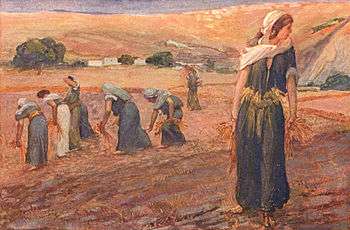
Tractate Peah in the Mishnah, Tosefta, and Jerusalem Talmud interpreted the laws of the harvest of the corner of the field and gleanings to be given to the poor in Leviticus 19:9–10 and 23:22, and Deuteronomy 24:19–21.[166]
The Mishnah taught that the Torah defines no minimum or maximum for the donation of the corners of one’s field to the poor.[167] But the Mishnah also taught that one should not make the amount left to the poor less than one-sixtieth of the entire crop. And even though no definite amount is given, the amount given should accord with the size of the field, the number of poor people, and the extent of the yield.[168]
Rabbi Eliezer taught that one who cultivates land in which one can plant a quarter kav of seed is obligated to give a corner to the poor. Rabbi Joshua said land that yields two seah of grain. Rabbi Tarfon said land of at least six handbreadths by six handbreadths. Rabbi Judah ben Betera said land that requires two strokes of a sickle to harvest, and the law is as he spoke. Rabbi Akiva said that one who cultivates land of any size is obligated to give a corner to the poor and the first fruits.[169]
The Mishnah taught that the poor could enter a field to collect three times a day — in the morning, at midday, and in the afternoon. Rabban Gamliel taught that they said this only so that landowners should not reduce the number of times that the poor could enter. Rabbi Akiva taught that they said this only so that landowners should not increase the number of times that the poor had to enter. The landowners of Beit Namer used to harvest along a rope and allowed the poor to collect a corner from every row.[170]
The Mishnah defined “a defective cluster (עוֹלֶלֶת, olelet)” within the meaning of Leviticus 19:10 and Deuteronomy 24:21 to mean any cluster that had neither a shoulder nor a dangling portion (but rather was entirely attached to the main stem). If the cluster had a shoulder or a dangling portion, it belonged to the property owner, but if there was a doubt, it belonged to the poor. A cluster that was attached to the joint between branches or the stem and the trunk, if it was plucked with the grape cluster, it belonged to the property owner; if not, it belonged to the poor. Rabbi Judah said that a single-grape cluster was a cluster, but the Sages said that it was a defective cluster (and thus belonged to the poor).[171]
The Mishnah taught that if a wife foreswore all benefit from other people, her husband could not annul his wife’s vow, but she could still benefit from the gleanings, forgotten sheaves, and the corner of the field that Leviticus 19:9–10 and 23:22, and Deuteronomy 24:19–21 commanded farmers to leave for the poor.[172]
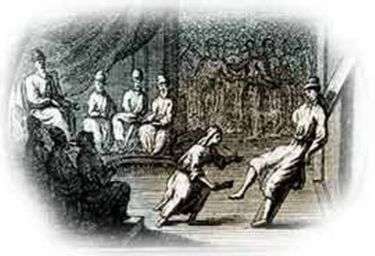
Deuteronomy chapter 25
Tractate Yevamot in the Mishnah, Tosefta, Jerusalem Talmud, and Babylonian Talmud interpreted the laws of levirate marriage (יִבּוּם, yibbum) in Deuteronomy 25:5–10.[173]
Interpreting the laws of Levirite marriage (יִבּוּם, yibbum) under Deuteronomy 25:5–6, the Gemara read Exodus 21:4 to address a Hebrew slave who married the Master’s Canaanite slave, and deduced from Exodus 21:4 that the children of such a marriage were also considered Canaanite slaves and thus that their lineage flowed from their mother, not their father. The Gemara used this analysis of Exodus 21:4 to explain why Mishnah Yevamot 2:5[174] taught that the son of a Canaanite slave mother does not impose the obligation of Levirite marriage (יִבּוּם, yibbum) under Deuteronomy 25:5–6.[175]
Chapter 3 in tractate Makkot in the Mishnah and Babylonian Talmud interpreted the laws of punishment by lashes in Deuteronomy 25:1–3.[176]
The Gemara interpreted Deuteronomy 25:13–15 to teach that both one's wealth and one's necessities depend on one's honesty.[177]
Reading Deuteronomy 25:15, Rabbi Levi taught that blessed actions bless those who are responsible for them, and cursed actions curse those who are responsible for them. The Midrash interpreted the words of Deuteronomy 25:15, "A perfect and just weight you shall have," to mean that if one acts justly, one will have something to take and something to give, something to buy and something to sell. Conversely, the Midrash read Deuteronomy 25:13–14 to teach, "You shall not have (possessions if there are) in your bag diverse weights, a great and a small. You shall not have (possessions if there are) in your house diverse measures, a great and a small." Thus, if one does employ deceitful measures, one will not have anything to take or give, to buy or sell. The Midrash taught that God tells businesspeople that they "may not make" one measure great and another small, but if they do, they "will not make" a profit. The Midrash likened this commandment to that of Exodus 20:19 (20:20 in the NJPS) "You shall not make with Me gods of silver, or gods of gold, you shall not make," for if a person did make gods of silver and gold, then that person would not be able to afford to have even gods of wood or stone.[178]

Rabbi Levi taught that the punishment for false weights or measures (discussed at Deuteronomy 25:13–16) was more severe than that for having intimate relations with forbidden relatives (discussed at Leviticus 18:6–20). For in discussing the case of forbidden relatives, Leviticus 18:27 uses the Hebrew word אֵל, eil, for the word "these," whereas in the case of false weights or measures, Deuteronomy 25:16 uses the Hebrew word אֵלֶּה, eileh, for the word "these" (and the additional ה, eh at the end of the word implies additional punishment.) The Gemara taught that one can derive that אֵל, eil, implies rigorous punishment from Ezekiel 17:13, which says, "And the mighty (אֵילֵי, eilei) of the land he took away." The Gemara explained that the punishments for giving false measures are greater than those for having relations with forbidden relatives because for forbidden relatives, repentance is possible (as long as there have not been children), but with false measure, repentance is impossible (as one cannot remedy the sin of robbery by mere repentance; the return of the things robbed must precede it, and in the case of false measures, it is practically impossible to find out all the members of the public who have been defrauded).[179]
Rabbi Hiyya taught that the words of Leviticus 19:35, "You shall do no unrighteousness in judgment," apply to judgment in law. But a Midrash noted that Leviticus 19:15 already mentioned judgment in law, and questioned why Leviticus 19:35 would state the same proposition again and why Leviticus 19:35 uses the words, "in judgment, in measures." The Midrash deduced that Leviticus 19:35 teaches that a person who measures is called a judge, and one who falsifies measurements is called by the five names "unrighteous," "hated," "repulsive," "accursed," and an "abomination," and is the cause of these five evils. Rabbi Banya said in the name of Rav Huna that the government comes and attacks that generation whose measures are false. The Midrash found support for this from Proverbs 11:1, "A false balance is an abomination to the Lord," which is followed by Proverbs 11:2, "When presumption comes, then comes shame." Reading Micah 6:11, "Shall I be pure with wicked balances?" Rabbi Berekiah said in the name of Rabbi Abba that it is impossible for a generation whose measures are false to be meritorious, for Micah 6:11 continues, "And with a bag of deceitful weights" (showing that their holdings would be merely illusory). Rabbi Levi taught that Moses also hinted to Israel that a generation with false measures would be attacked. Deuteronomy 25:13–14 warns, "You shall not have in your bag diverse weights . . . you shall not have in your house diverse measures." But if one does, one will be attacked, as Deuteronomy 25:16, reports, "For all who do such things, even all who do unrighteously, are an abomination to the Lord your God," and then immediately following, Deuteronomy 25:17 says, "Remember what Amalek did to you (attacking Israel) by the way as you came forth out of Egypt."[180]
Rabbi Judah said that three commandments were given to the Israelites when they entered the land: (1) the commandment of Deuteronomy 17:14–15 to appoint a king, (2) the commandment of Deuteronomy 25:19 to blot out Amalek, and (3) the commandment of Deuteronomy 12:10–11 to build the Temple in Jerusalem. Rabbi Nehorai, on the other hand, said that Deuteronomy 17:14–15 did not command the Israelites to choose a king, but was spoken only in anticipation of the Israelites’ future complaints, as Deuteronomy 17:14 says, "And (you) shall say, ‘I will set a king over me.’"[181]
In medieval Jewish interpretation
The parashah is discussed in these medieval Jewish sources:[182]
Deuteronomy chapter 22
Abraham ibn Ezra wrote that the commandment of Deuteronomy 22:1–3 to return lost property appears in the Torah portion that begins in Deuteronomy 21:10, “When you go forth to battle” ( כִּי-תֵצֵא לַמִּלְחָמָה, ki tetze la-milchamah), to teach that the duty to return lost property applies even in a time of war.[183]

Reading Deuteronomy 22:1–3, Maimonides taught that if a person sees a lost object and the person’s father says not to return it, the person should return it instead of obeying the person’s father. For by obeying the father and fulfilling the positive commandment “Honor your father” in Exodus 20:11,[184] the person would violate the positive commandment “And you shall certainly return it,” as well as the negative commandment “You may not ignore it.”[185] And reading Deuteronomy 22:3, “All objects lost by your colleague,” Maimonides taught that if a person sees flood waters coming that will ruin a building or a field belonging to a colleague, the person is obligated to put up a barrier before the waters to check them. Maimonides said that the mention of “All” in Deuteronomy 22:3 includes the devastation of property.[186]
Maimonides wrote that the object of the law of restoring lost property to its owner in Deuteronomy 22:1–3 is plain. In the first instance, it is in itself a good feature in a person’s character. Secondly, its benefit is mutual: For if a person does not return the lost property of another, nobody will restore to the person what the person may lose, just as those who do not honor their parents cannot expect to be honored by their children.[187]
The Sefer ha-Chinuch also taught that the root of Deuteronomy 22:1–3 is plain — as there is in it a benefit to all, and to the ordering of the state, as all people are forgetful, and their animals flee here and there. The Sefer ha-Chinuch argued that with this commandment in place, beasts and vessels will be safe anywhere in the holy land as if they were under the hand of their owners.[188]
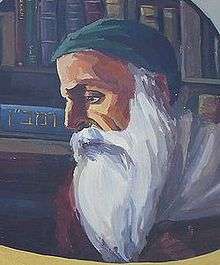
Nachmanides noted that Deuteronomy 22:2 says “your brother’s,” while the parallel commandment in Exodus 23:4 states “your enemy’s” and Exodus 23:5 says “of him who hates you.” Nachmanides taught that Scripture thus means to say, “Do this for him (in assisting him), and remember the brotherhood between you and forget the hatred.”[189]
Similarly, Bahya ben Asher noted the parallel between Deuteronomy 22:1–3 and Exodus 23:5. Bahya concluded that Deuteronomy 22:1–3 thus promises that if you assist your enemy with his falling donkey, he will eventually appreciate you and become “your brother.” When you assist him, he will forget the “hatred” between you and only remember the bond of love that unites brothers. Bahya taught that there is more to the commandment to restore lost property than merely the act of restoring it. If one is in a position to perform a useful service for one’s fellow and to thereby protect one’s fellow against loss, this is part of the commandment. Bahya also found in Deuteronomy 22:1–3 encouragement regarding the resurrection, reading that God will practice this commandment personally by restoring the souls of the departed bodies to their original owners after the arrival of the Messiah. Noting that Deuteronomy 22:3 continues, “You must not hide yourself,” Bahya found the moral lesson: Do not hide yourself from God, so that when the time comes, God will not hide from you.[190]
Maimonides read Deuteronomy 22:4, “You shall not see your brother's ass or his ox fallen down by the way, and hide yourself from them; you shall surely help him to lift them up again,” together with Exodus 23:5, “If you see the ass of him that hates you lying under its burden, you shall forbear to pass by him; you shall surely release it with him.”[191] Maimonides taught that when a person encounters a colleague on a journey and the colleague’s animal has fallen under its load, Exodus 23:5 commands the person to unload the burden from it, whether or not the animal was carrying an appropriate burden for it.[192] Maimonides interpreted Deuteronomy 22:4 to command that one should not unload the animal and depart, leaving the wayfarer in panic, but one should lift up the animal together with its owner, and reload the animal’s burden on it.[193] Maimonides taught that the general principle is that if the animal were one’s own and one would unload and reload it, one is obligated to unload and reload it for a colleague. If one is pious and goes beyond the measure of the law, even if one is a great prince, and sees an animal belonging to a colleague fallen under a load of straw, reeds or the like, one should unload and load it with its owner.[194] Maimonides interpreted the intensified form of the verbs in Exodus 23:5 and Deuteronomy 22:4 to indicate that if one unloaded and reloaded the animal, and it fell again, one is obligated to unload and reload it another time, indeed even 100 times. Thus, one must accompany the animal for a distance thereafter, unless the owner of the burden says that it is not necessary.[195] Maimonides read Exodus 23:5 to obligate one when one sees the fallen animal in a way that can be described as an encounter, for Exodus 23:5 says, “When you see your colleague’s donkey,” and Exodus 23:4 says, “When you encounter . . . .”[196] Maimonides taught that if one finds an animal belonging to a colleague fallen under its load, it is a commandment to unload and reload it even if its owner is not present, for the words “You shall certainly help” and “You shall certainly lift up” imply that one must fulfill these commandments in all situations. Maimonides said that Exodus 23:5 says “together with him” (that is, the animal’s owner) to teach that if the owner of the animal was there and goes off to the side and relies on the passerby to unload it alone because the passerby is subject to a commandment, then the passerby is not obligated. If the owner of the animal is old or ailing, however, the passerby is obligated to load and unload the animal alone.[197]
Rabbi David Kimchi stated that a parapet (Deuteronomy 22:8) needed to be "ten hands high, or more, that a person might not fall from it".[198]
Deuteronomy chapter 23
Maimonides used Deuteronomy 23:8 to interpret how far to extend the principle of charity. Maimonides taught that the Law correctly says in Deuteronomy 15:11, "You shall open your hand wide to your brother, to your poor." Maimonides continued that the Law taught how far we have to extend this principle of treating kindly every one with whom we have some relationship — even if the other person offended or wronged us, even if the other person is very bad, we still must have some consideration for the other person. Thus Deuteronomy 23:8 says: "You shall not abhor an Edomite, for he is your brother." And if we find a person in trouble, whose assistance we once enjoyed, or of whom we have received some benefit, even if that person has subsequently wronged us, we must bear in mind that person’s previous good conduct. Thus Deuteronomy 23:8 says: "You shall not abhor an Egyptian, because you were a stranger in his land," although the Egyptians subsequently oppressed the Israelites very much.[199]
Deuteronomy chapter 25
Reading the words of Deuteronomy 24:17, "You shall not take a widow’s raiment to pledge," Maimonides taught that collateral may not be taken from a widow, whether she is rich or poor, whether it is taken at the time the loan is given or after the time the loan is given, and even when a court would supervise the matter. Maimonides continued that if a creditor takes such collateral, it must be returned, even against the creditor’s will. If the widow admits the debt, she must pay, but if she denies its existence, she must take an oath. If the security the creditor took was lost or consumed by fire before the creditor returned it, the creditor was punished by lashes.[200]
In modern interpretation
The parashah is discussed in these modern sources:
Deuteronomy chapter 21
Professor Tamara Cohn Eskenazi of the Hebrew Union College-Jewish Institute of Religion cited Deuteronomy 21:10–14, which describes a process by which a woman captured in war could become the wife of an Israelite man, as an example of intermarriage in the Torah, for although the text does not specify the woman’s ethnic identity, the context implies that she was non-Israelite.[201]
Rabbi David Wolpe of Sinai Temple said that although the law of the beautiful captive is barbaric by the ethical standards of the 21st century, it was ahead of its time by the ethical standards of antiquity. The law, according to Wolpe, indicates that the Torah distrusts people to control their sexual urges towards people over whom they hold power.[202]
Deuteronomy chapter 22
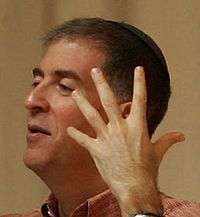
Rabbi Donniel Hartman argued that Deuteronomy 22:1–3 contains one of Judaism’s central answers to the question of what is just and right, what he called “the religious ethic of nonindifference.”[203]
Writing for the Committee on Jewish Law and Standards of Conservative Judaism, Rabbis Elliot N. Dorff and Aaron L. Mackler relied on Deuteronomy 22:2, among other verses, to find a duty to help see that our society provides health care to those who need it. Dorff and Mackler noted that the Rabbis found the authorization and requirement to heal in several verses, including Exodus 21:19–20, according to which an assailant must insure that his victim is “thoroughly healed,” and Deuteronomy 22:2, “And you shall restore the lost property to him.” Dorff and Mackler reported that on the basis of an extra letter in the Hebrew text of Deuteronomy 22:2, the Talmud declared that Deuteronomy 22:2 includes the obligation to restore another person’s body as well as his or her property, and hence there is an obligation to come to the aid of someone in a life-threatening situation.[204]
Professor William Dever of Lycoming College noted that most of the 100 linen and wool fragments, likely textiles used for cultic purposes, that archeologists found at Kuntillet Ajrud in the Sinai Desert (where the climate may better preserve organic materials) adhered to the regulations in Leviticus 19:19 and Deuteronomy 22:11.[205]

In April 2014, the Committee on Jewish Law and Standards of Conservative Judaism ruled that women are now equally responsible for observing commandments as men have been, and that women are thus responsible for the mitzvah of wearing tzitzit, as commanded in Deuteronomy 22:12.[206]
Deuteronomy chapter 25
Professor James Kugel of Bar Ilan University noted that Deuteronomy shares certain favorite themes with Wisdom literature, such as the prohibition of using false weights in Deuteronomy 25:13–16 and Proverbs 11:1, 20:10 and 23. As well, in the wisdom perspective, history is the repository of eternal truths, lessons that never grow old, and thus Deuteronomy constantly urges its readers to "remember," as Deuteronomy 25:17 does when it admonishes to "Remember what Amalek did to you." Kugel concluded that the Deuteronomist was closely connected to the world of wisdom literature.[207]

In critical analysis
Some scholars who follow the Documentary Hypothesis consider all of the parashah to have been part of the original Deuteronomic Code (sometimes abbreviated Dtn) that the first Deuteronomistic historian (sometimes abbreviated Dtr 1) included in the edition of Deuteronomy that existed during Josiah’s time.[208]
Commandments
According to the Sefer ha-Chinuch, there are 27 positive and 47 negative commandments in the parashah.[209]
- To keep the laws of the captive woman[210]
- Not to sell the captive woman into slavery[8]
- Not to retain the captive woman for servitude after having relations with her[8]
- The courts must hang those stoned for blasphemy or idolatry.[211]
- To bury the executed on the day that they die[212]
- Not to delay burial overnight[212]
- To return a lost object to its owner[213]
- Not to turn a blind eye to a lost object[214]
- Not to leave another’s beast lying under its burden[19]
- To lift up a load for a Jew[19]
- Women must not wear men's clothing.[21]
- Men must not wear women's clothing.[21]
- Not to take the mother bird from her children[215]
- To release the mother bird if she was taken from the nest[216]
- To build a parapet[24]
- Not to leave a stumbling block about[24]
- Not to plant grains or greens in a vineyard[25]
- Not to eat diverse seeds planted in a vineyard[25]
- Not to do work with two kinds of animals together[26]
- Not to wear cloth of wool and linen[27]
- To marry a wife by means of ketubah and kiddushin[217]
- The slanderer must remain married to his wife.[32]
- The slanderer must not divorce his wife.[32]
- The court must have anyone who merits stoning stoned to death.[218]
- Not to punish anyone compelled to commit a transgression[219]
- The rapist must marry his victim if she chooses.[220]
- The rapist is not allowed to divorce his victim.[220]
- Not to let a eunuch marry into the Jewish people[42]
- Not to let the child of a prohibited union (מַמְזֵר, mamzer) marry into the Jewish people[43]
- Not to let Moabite and Ammonite men marry into the Jewish people[44]
- Not to ever offer peace to Moab or Ammon[221]
- Not to exclude a third generation Edomite convert from marrying into the Jewish people[222]
- To exclude Egyptian converts from marrying into the Jewish people only for the first two generations[222]
- A ritually unclean person should not enter the camp of the Levites.[223]
- To prepare a place of easement in a camp[224]
- To prepare a boring-stick or spade for easement in a camp[225]
- Not to return a slave who fled into Israel from his master abroad[226]
- Not to oppress a slave who fled into Israel from his master abroad[227]
- Not to have relations with women not married by means of ketubah and kiddushin[228]
- Not to bring the wage of a harlot or the exchange price of a dog as a holy offering[229]
- Not to borrow at interest from a Jew[230]
- To lend at interest to a non-Jew if the non-Jew needs a loan, but not to a Jew[231]
- Not to be tardy with vowed and voluntary offerings[232]
- To fulfill whatever goes out from one’s mouth[233]
- To allow a hired worker to eat certain foods while under hire[59]
- That a hired hand should not raise a sickle to another’s standing grain[59]
- That a hired hand is forbidden to eat from the employer’s crops during work[60]
- To issue a divorce by means of a get document[234]
- A man must not remarry his ex-wife after she has married someone else.[235]
- Not to demand from the bridegroom any involvement, communal or military during the first year[63]
- To give him who has taken a wife, built a new home, or planted a vineyard a year to rejoice therewith[63]
- Not to demand as collateral utensils needed for preparing food[64]
- The metzora must not remove his signs of impurity.[236]
- The creditor must not forcibly take collateral.[237]
- Not to delay return of collateral when needed[238]
- To return the collateral to the debtor when needed[239]
- To pay wages on the day that they were earned[240]
- Relatives of the litigants must not testify.[73]
- A judge must not pervert a case involving a convert or orphan.[241]
- Not to demand collateral from a widow[241]
- To leave the forgotten sheaves in the field[76]
- Not to retrieve the forgotten sheaves[76]
- The precept of whiplashes for the wicked[242]
- The court must not exceed the prescribed number of lashes.[243]
- Not to muzzle an ox while plowing[80]
- The widow must not remarry until the ties with her brother-in-law are removed.[244]
- To marry a childless brother's widow (to do yibum)[244]
- To free a widow from yibum (to do חליצה, chalitzah)[245]
- To save someone being pursued by a killer, even by taking the life of the pursuer[246]
- To have no mercy on a pursuer with intent to kill[246]
- Not to possess inaccurate scales and weights even if they are not for use[247]
- To remember what Amalek did to the Jewish people[248]
- To wipe out the descendants of Amalek[91]
- Not to forget Amalek’s atrocities and ambush on the Israelites’ journey from Egypt in the desert[91]
In the liturgy
The parashah is reflected in these parts of the Jewish liturgy:
Following the Shacharit morning prayer service, some Jews recite the Six Remembrances, among which is Deuteronomy 24:9, "Remember what the Lord your God did to Miriam by the way as you came forth out of Egypt," recalling that God punished Miriam with skin disease (צָּרַעַת, tzara’at).[249]
The Weekly Maqam
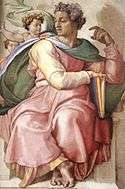
In the Weekly Maqam, Sephardi Jews each week base the songs of the services on the content of that week's parashah. For Parashah Ki Teitzei, Sephardi Jews apply Maqam Saba. Saba, in Hebrew, literally means "army." It is appropriate here, because the parashah commences with the discussion of what to do in certain cases of war with the army.
Haftarah
The haftarah for the parashah is Isaiah 54:1–10. The haftarah is the fifth in the cycle of seven haftarot of consolation after Tisha B'Av, leading up to Rosh Hashanah.
Notes
- ↑ "Devarim Torah Stats". Akhlah Inc. Retrieved July 6, 2013.
- ↑ "Parashat Ki Teitzei". Hebcal. Retrieved August 28, 2014.
- ↑ Esther 1:1–10:3.
- ↑ Seder Eliyahu Rabbah chapter 20. Targum Sheni to Esther 4:13.
- ↑ See, e.g., The Schottenstein Edition Interlinear Chumash: Devarim / Deuteronomy. Edited by Menachem Davis, pages 136–61. Brooklyn: Mesorah Publications, 2009. ISBN 978-1-4226-0210-2.
- ↑ Deuteronomy 21:10–13.
- ↑ Deuteronomy 21:13.
- 1 2 3 Deuteronomy 21:14.
- ↑ See, e.g., The Schottenstein Edition Interlinear Chumash: Devarim / Deuteronomy. Edited by Menachem Davis, page 137.
- ↑ Deuteronomy 21:15–17.
- ↑ See, e.g., The Schottenstein Edition Interlinear Chumash: Devarim / Deuteronomy. Edited by Menachem Davis, page 138.
- ↑ Deuteronomy 21:18–20.
- ↑ Deuteronomy 21:21.
- 1 2 See, e.g., The Schottenstein Edition Interlinear Chumash: Devarim / Deuteronomy. Edited by Menachem Davis, page 139.
- ↑ Deuteronomy 21:22–23.
- ↑ Deuteronomy 22:1–3.
- ↑ Deuteronomy 22:2–3.
- ↑ See, e.g., The Schottenstein Edition Interlinear Chumash: Devarim / Deuteronomy. Edited by Menachem Davis, page 140.
- 1 2 3 Deuteronomy 22:4.
- 1 2 See, e.g., The Schottenstein Edition Interlinear Chumash: Devarim / Deuteronomy. Edited by Menachem Davis, page 141.
- 1 2 3 Deuteronomy 22:5.
- ↑ Deuteronomy 22:6–7.
- 1 2 3 See, e.g., The Schottenstein Edition Interlinear Chumash: Devarim / Deuteronomy. Edited by Menachem Davis, page 142.
- 1 2 3 Deuteronomy 22:8.
- 1 2 3 Deuteronomy 22:9.
- 1 2 Deuteronomy 22:10.
- 1 2 Deuteronomy 22:11.
- ↑ Deuteronomy 22:12.
- ↑ See, e.g., The Schottenstein Edition Interlinear Chumash: Devarim / Deuteronomy. Edited by Menachem Davis, page 143.
- ↑ Deuteronomy 22:13–17.
- ↑ Deuteronomy 22:18–19.
- 1 2 3 Deuteronomy 22:19.
- 1 2 3 See, e.g., The Schottenstein Edition Interlinear Chumash: Devarim / Deuteronomy. Edited by Menachem Davis, page 144.
- ↑ Deuteronomy 22:20–21.
- ↑ Deuteronomy 22:22.
- ↑ Deuteronomy 22:23–24.
- 1 2 3 See, e.g., The Schottenstein Edition Interlinear Chumash: Devarim / Deuteronomy. Edited by Menachem Davis, page 145.
- ↑ Deuteronomy 22:25–27.
- ↑ Deuteronomy 22:28–29.
- ↑ Deuteronomy 23:1.
- 1 2 3 See, e.g., The Schottenstein Edition Interlinear Chumash: Devarim / Deuteronomy. Edited by Menachem Davis, page 146.
- 1 2 Deuteronomy 23:2.
- 1 2 Deuteronomy 23:3.
- 1 2 Deuteronomy 23:4.
- ↑ Deuteronomy 23:5–7.
- 1 2 See, e.g., The Schottenstein Edition Interlinear Chumash: Devarim / Deuteronomy. Edited by Menachem Davis, page 147.
- ↑ Deuteronomy 23:8.
- ↑ Deuteronomy 23:9.
- ↑ Deuteronomy 23:11–12.
- ↑ Deuteronomy 23:13–14.
- ↑ Deuteronomy 23:15.
- 1 2 3 See, e.g., The Schottenstein Edition Interlinear Chumash: Devarim / Deuteronomy. Edited by Menachem Davis, page 149.
- ↑ Deuteronomy 23:16–17.
- ↑ Deuteronomy 23:18–19.
- ↑ Deuteronomy 23:20–21.
- ↑ See, e.g., The Schottenstein Edition Interlinear Chumash: Devarim / Deuteronomy. Edited by Menachem Davis, page 150.
- ↑ Deuteronomy 23:22–24.
- 1 2 3 See, e.g., The Schottenstein Edition Interlinear Chumash: Devarim / Deuteronomy. Edited by Menachem Davis, page 151.
- 1 2 3 Deuteronomy 23:25.
- 1 2 Deuteronomy 23:26.
- ↑ Deuteronomy 24:1–4.
- ↑ See, e.g., The Schottenstein Edition Interlinear Chumash: Devarim / Deuteronomy. Edited by Menachem Davis, page 152.
- 1 2 3 Deuteronomy 24:5.
- 1 2 Deuteronomy 24:6.
- 1 2 3 See, e.g., The Schottenstein Edition Interlinear Chumash: Devarim / Deuteronomy. Edited by Menachem Davis, page 153.
- ↑ Deuteronomy 24:7.
- ↑ Deuteronomy 24:8–9.
- ↑ Deuteronomy 24:10–11.
- ↑ Deuteronomy 24:12–13.
- ↑ See, e.g., The Schottenstein Edition Interlinear Chumash: Devarim / Deuteronomy. Edited by Menachem Davis, page 154.
- ↑ Deuteronomy 24:14–15.
- ↑ See, e.g., The Schottenstein Edition Interlinear Chumash: Devarim / Deuteronomy. Edited by Menachem Davis, pages 154–55.
- 1 2 Deuteronomy 24:16.
- 1 2 3 See, e.g., The Schottenstein Edition Interlinear Chumash: Devarim / Deuteronomy. Edited by Menachem Davis, page 155.
- ↑ Deuteronomy 24:17–18.
- 1 2 3 Deuteronomy 24:19.
- ↑ Deuteronomy 24:20–22.
- ↑ See, e.g., The Schottenstein Edition Interlinear Chumash: Devarim / Deuteronomy. Edited by Menachem Davis, page 156.
- ↑ Deuteronomy 25:1–3.
- 1 2 Deuteronomy 25:4.
- ↑ See, e.g., The Schottenstein Edition Interlinear Chumash: Devarim / Deuteronomy. Edited by Menachem Davis, page 157.
- ↑ Deuteronomy 25:5–6.
- ↑ Deuteronomy 25:7–9.
- ↑ Deuteronomy 25:10.
- 1 2 See, e.g., The Schottenstein Edition Interlinear Chumash: Devarim / Deuteronomy. Edited by Menachem Davis, page 159.
- ↑ Deuteronomy 25:11–12.
- ↑ Deuteronomy 25:13–16.
- ↑ See, e.g., The Schottenstein Edition Interlinear Chumash: Devarim / Deuteronomy. Edited by Menachem Davis, page 160.
- ↑ See, e.g., The Schottenstein Edition Interlinear Chumash, pages 160–61.
- ↑ Deuteronomy 25:17–18.
- 1 2 3 Deuteronomy 25:19.
- ↑ See, e.g., The Schottenstein Edition Interlinear Chumash: Devarim / Deuteronomy. Edited by Menachem Davis, page 161.
- ↑ See, e.g., Richard Eisenberg "A Complete Triennial Cycle for Reading the Torah." Proceedings of the Committee on Jewish Law and Standards of the Conservative Movement: 1986–1990, pages 383–418. New York: The Rabbinical Assembly, 2001. ISBN 0-91-6219-18-6.
- ↑ Code of Hammurabi, article 94. Babylonia, Circa 1780 BCE. Reprinted in e.g. Ancient Near Eastern Texts Relating to the Old Testament. Edited by James B. Pritchard, pages 163, 169. Princeton: Princeton University Press, 1969. ISBN 0-691-03503-2.
- ↑ All examples taken from BibleGateway.com, accessed 27 December 2015
- ↑ For more on inner-Biblical interpretation, see, e.g., Benjamin D. Sommer. "Inner-biblical Interpretation." In The Jewish Study Bible: Second Edition. Edited by Adele Berlin and Marc Zvi Brettler, pages 1835–41. New York: Oxford University Press, 2014. ISBN 978-0-19-997846-5.
- ↑ Benjamin D. Sommer. "Inner-biblical Interpretation." In The Jewish Study Bible: Second Edition. Edited by Adele Berlin and Marc Zvi Brettler, page 1836.
- ↑ Deuteronomy 21:17
- ↑ Genesis 48:22,
- ↑ Jamieson-Fausset-Brown Bible Commentary, on Deuteronomy 21, accessed 22 December 2015
- ↑ "Ammonites". Catholic Encyclopedia. 2015-03-10.
- ↑ Deuteronomy 23:3
- ↑ Gill's Exposition of the Entire Bible on Deuteronomy 23, accessed 26 December 2015
- ↑ Professor Amy-Jill Levine of Vanderbilt University Divinity School suggested that Amos used freedom from slavery as the paradigm and template against which he expressed concerns about the covenant community, casting the community in the role of Pharaoh when they transgressed. See Amy-Jill Levine. "The Prophets and the Fall of the North." In The Old Testament: Part II. Springfield, Virginia: The Teaching Company, 2001.
- ↑ 1 Samuel 15:32–33
- ↑ For more on early nonrabbinic interpretation, see, e.g., Esther Eshel. "Early Nonrabbinic Interpretation." In The Jewish Study Bible: Second Edition. Edited by Adele Berlin and Marc Zvi Brettler, pages 1841–59.
- ↑ Lawrence H. Schiffman. Reclaiming the Dead Sea Scrolls: The History of Judaism, the Background of Christianity, the Lost Library of Qumran, page 107. Philadelphia: Jewish Publication Society, 1994. ISBN 0-8276-0530-7. (citing Zadokite Fragments 13:14–16 = Da 18 II 1–4).
- ↑ Philo. On the Birth of Abel and the Sacrifices Offered by Him and by His Brother Cain Archived 2015-08-05 at the Wayback Machine., chapters 13–14 (¶¶ 52–58). Alexandria, Egypt, early 1st century CE. Reprinted in, e.g., The Works of Philo: Complete and Unabridged, New Updated Edition. Translated by Charles Duke Yonge, page 101. Peabody, Massachusetts: Hendrickson Publishers, 1993. ISBN 0-943575-93-1.
- ↑ Dead Sea scroll 4Q159. Land of Israel, late 1st century BCE. Reprinted in Géza Vermes. The Complete Dead Sea Scrolls in English: Revised Edition, pages 529–30. New York: Penguin Books, 2011. ISBN 978-0-141-19731-9.
- ↑ For more on classical rabbinic interpretation, see, e.g., Yaakov Elman. "Classical Rabbinic Interpretation." In The Jewish Study Bible: Second Edition. Edited by Adele Berlin and Marc Zvi Brettler, pages 1859–78.
- ↑ Babylonian Talmud Kiddushin 21b–22a. Babylonia, 6th century. Reprinted in, e.g., Talmud Bavli. Elucidated by David Fohrman, Dovid Kamenetsky, and Hersh Goldwurm; edited by Hersh Goldwurm, volume 36, pages 21b3–22a1. Brooklyn: Mesorah Publications, 1992. ISBN 1-57819-642-6.
- ↑ Babylonian Talmud Sotah 35b. Reprinted in, e.g., Talmud Bavli. Elucidated by Eliezer Herzka, Moshe Zev Einhorn, Michoel Weiner, Dovid Kamenetsky, and Reuvein Dowek; edited by Yisroel Simcha Schorr and Chaim Malinowitz, volume 33b, pages 35b3–4. Brooklyn: Mesorah Publications, 2000. ISBN 1-57819-673-6.
- ↑ Babylonian Talmud Yevamot 47b. Reprinted in, e.g., Talmud Bavli. Elucidated by Zev Meisels, Feivel Wahl, Eliezer Herzka, Avrohom Neuberger, Asher Dicker, Mendy Wachsman; edited by Yisroel Simcha Schorr and Chaim Malinowitz, volume 24, page 47b4. Brooklyn: Mesorah Publications, 1999. ISBN 1-57819-669-8.
- ↑ Babylonian Talmud Yevamot 48a. Reprinted in, e.g., Talmud Bavli. Elucidated by Zev Meisels, Feivel Wahl, Eliezer Herzka, Avrohom Neuberger, Asher Dicker, Mendy Wachsman; edited by Yisroel Simcha Schorr and Chaim Malinowitz, volume 24, page 48a3.
- ↑ Babylonian Talmud Yevamot 48b. Reprinted in, e.g., Talmud Bavli. Elucidated by Zev Meisels, Feivel Wahl, Eliezer Herzka, Avrohom Neuberger, Asher Dicker, Mendy Wachsman; edited by Yisroel Simcha Schorr and Chaim Malinowitz, volume 24, page 48b1.
- ↑ Mishnah Bava Batra 8:4–5. Land of Israel, circa 200 CE. Reprinted in, e.g., The Mishnah: A New Translation. Translated by Jacob Neusner, pages 574–75. New Haven: Yale University Press, 1988. ISBN 0-300-05022-4. Babylonian Talmud Bava Batra 122b–33b. Reprinted in, e.g., Talmud Bavli. Elucidated by Yosef Asher Weiss; edited by Hersh Goldwurm, volume 46, pages 122b1–33b1. Brooklyn: Mesorah Publications, 1994. ISBN 1-57819-646-9.
- ↑ Babylonian Talmud Bava Batra 122b–34a. Reprinted in, e.g., Talmud Bavli. Elucidated by Yosef Asher Weiss; edited by Hersh Goldwurm, volume 46, pages 122b1–34a2.
- ↑ Mishnah Bekhorot 8:9. Reprinted in, e.g., The Mishnah: A New Translation. Translated by Jacob Neusner, pages 806–07. Babylonian Talmud Bekhorot 51b–52b. Archived 2010-10-06 at the Wayback Machine. Reprinted in, e.g., Talmud Bavli. Elucidated by Noson Boruch Herzka, Michoel Weiner, Henoch Moshe Levin, Mendy Wachsman, Asher Septimus, and Eliezer Herzka; edited by Yisroel Simcha Schorr and Chaim Malinowitz, volume 66, pages 51b3–52b1. Brooklyn: Mesorah Publications, 2004. ISBN 1-57819-666-3.
- ↑ Babylonian Talmud Bekhorot 51b–52b. Archived 2010-10-06 at the Wayback Machine. Reprinted in, e.g., Talmud Bavli. Elucidated by Noson Boruch Herzka, Michoel Weiner, Henoch Moshe Levin, Mendy Wachsman, Asher Septimus, and Eliezer Herzka; edited by Yisroel Simcha Schorr and Chaim Malinowitz, volume 66, pages 51b3–52b4.
- ↑ Mishnah Bava Batra 8:4. Reprinted in, e.g., The Mishnah: A New Translation. Translated by Jacob Neusner, page 574. Babylonian Talmud Bava Batra 122b. Reprinted in, e.g., Talmud Bavli. Elucidated by Yosef Asher Weiss; edited by Hersh Goldwurm, volume 46, page 122b1.
- ↑ Mishnah Bava Batra 8:5. Reprinted in, e.g., The Mishnah: A New Translation. Translated by Jacob Neusner, page 575. Babylonian Talmud Bava Batra 126b. Reprinted in, e.g., Talmud Bavli. Elucidated by Yosef Asher Weiss; edited by Hersh Goldwurm, volume 46, pages 126b1–2.
- ↑ Babylonian Talmud Bava Batra 111a–b. Reprinted in, e.g., Talmud Bavli. Elucidated by Yosef Asher Weiss; edited by Hersh Goldwurm, volume 45, pages 111a2–b2. Brooklyn: Mesorah Publications, 1994. ISBN 1-57819-645-0.
- ↑ Genesis Rabbah 61:7. Reprinted in, e.g., Midrash Rabbah: Genesis. Translated by Harry Freedman and Maurice Simon, volume 2, page 546.
- ↑ Mishnah Sanhedrin 8:1–7. Reprinted in, e.g., The Mishnah: A New Translation. Translated by Jacob Neusner, pages 599–602. Babylonian Talmud Sanhedrin 68b–75a. Reprinted in, e.g., Talmud Bavli. Elucidated by Michoel Weiner and Asher Dicker; edited by Yisroel Simcha Schorr and Chaim Malinowitz, volume 48, pages 68b1–75a2. Brooklyn: Mesorah Publications, 1994. ISBN 1-57819-630-2.
- ↑ Babylonian Talmud Sanhedrin 71a. Reprinted in, e.g., Talmud Bavli. Elucidated by Michoel Weiner and Asher Dicker; edited by Yisroel Simcha Schorr and Chaim Malinowitz, volume 48, page 71a3.
- ↑ Mishnah Sanhedrin 8:1. Reprinted in, e.g., The Mishnah: A New Translation. Translated by Jacob Neusner, pages 599–600. Babylonian Talmud Sanhedrin 68b. Reprinted in, e.g., Talmud Bavli. Elucidated by Michoel Weiner and Asher Dicker; edited by Yisroel Simcha Schorr and Chaim Malinowitz, volume 48, page 68b1.
- ↑ Babylonian Talmud Sanhedrin 68b.
- ↑ Mishnah Sanhedrin 8:4. Reprinted in, e.g., The Mishnah: A New Translation. Translated by Jacob Neusner, pages 600–01. Babylonian Talmud Sanhedrin 45b, 71a.
- ↑ Mishnah Bava Metzia 1:1–2:11. Reprinted in, e.g., The Mishnah: A New Translation. Translated by Jacob Neusner, pages 528–34. Tosefta Bava Metzia 1:1–2:33. Land of Israel, circa 250 CE. Reprinted in, e.g., The Tosefta: Translated from the Hebrew, with a New Introduction. Translated by Jacob Neusner, volume 2, pages 1023–29. Peabody, Massachusetts: Hendrickson Publishers, 2002. ISBN 1-56563-642-2. Babylonian Talmud Bava Metzia 2a–33b. Reprinted in, e.g., Talmud Bavli. Edited by Hersh Goldwurm, volume 41, pages 2a1–33b2. Brooklyn: Mesorah Publications, 1992. ISBN 1-57819-637-X.
- ↑ Mishnah Bava Kamma 5:7. Reprinted in, e.g., The Mishnah: A New Translation. Translated by Jacob Neusner, page 515. Babylonian Talmud Bava Kamma 54b.
- ↑ Mishnah Bava Metzia 2:9. Reprinted in, e.g., The Mishnah: A New Translation. Translated by Jacob Neusner, pages 532–33. Babylonian Talmud Bava Metzia 30b–31a.
- 1 2 3 4 Babylonian Talmud Bava Metzia 31a.
- ↑ Mishnah Bava Metzia 2:6. Reprinted in, e.g., The Mishnah: A New Translation. Translated by Jacob Neusner, page 532. Babylonian Talmud Bava Metzia 28a.
- ↑ Babylonian Talmud Kiddushin 34a. Reprinted in, e.g., Talmud Bavli. Elucidated by David Fohrman, Dovid Kamenetsky, and Hersh Goldwurm; edited by Hersh Goldwurm, volume 36, page 34a1. Brooklyn: Mesorah Publications, 1992. ISBN 1-57819-642-6.
- ↑ Sifre to Deuteronomy, chapter 225, 2:2. Land of Israel, circa 250–350 CE. Reprinted in, e.g., Sifre to Deuteronomy: An Analytical Translation. Translated by Jacob Neusner, volume 2, page 135. Atlanta: Scholars Press, 1987. ISBN 1-55540-145-7.
- ↑ Mishnah Chullin 12:1–5. Reprinted in, e.g., The Mishnah: A New Translation. Translated by Jacob Neusner, pages 786–87. Babylonian Talmud Chullin 138b–42a. Archived 2010-12-18 at the Wayback Machine.
- ↑ Mishnah Chullin 12:3. Reprinted in, e.g., The Mishnah: A New Translation. Translated by Jacob Neusner, pages 786–87. Babylonian Talmud Chullin 141a. Archived 2010-12-18 at the Wayback Machine.
- ↑ Mishnah Kilayim 1:1–9:10. Reprinted in, e.g., The Mishnah: A New Translation. Translated by Jacob Neusner, pages 49–68. Tosefta Kilayim 1:1–5:27. Reprinted in, e.g., The Tosefta: Translated from the Hebrew, with a New Introduction. Translated by Jacob Neusner, volume 1, pages 251–76. Jerusalem Talmud Kilayim 1a–84b. Land of Israel, circa 400 CE. Reprinted in, e.g., Talmud Yerushalmi. Elucidated by Menachem Goldberger, Chaim Ochs, Gershon Hoffman, Mordechai Weiskopf, Zev Dickstein, Michael Taubes, Avrohom Neuberger, Mendy Wachsman, David Azar, Michoel Weiner, and Abba Zvi Naiman; edited by Chaim Malinowitz, Mordechai Marcus, and Yisroel Simcha Schorr, volume 5. Brooklyn: Mesorah Publications, 2009. ISBN 1-4226-0244-3.
- ↑ Mishnah Makkot 3:9. Reprinted in, e.g., The Mishnah: A New Translation. Translated by Jacob Neusner, page 618. Babylonian Talmud Makkot 21b.
- ↑ Numbers Rabbah 19:5. 12th century. Reprinted in, e.g., Midrash Rabbah: Numbers. Translated by Judah J. Slotki, volume 6, page 755. London: Soncino Press, 1939. ISBN 0-900689-38-2.
- ↑ Babylonian Talmud Yoma 67b.
- ↑ Sifra Aharei Mot pereq 13, 194:2:11. Reprinted in, e.g., Sifra: An Analytical Translation. Translated by Jacob Neusner, volume 3, page 79. Atlanta: Scholars Press, 1988. ISBN 1-55540-207-0.
- ↑ Sifra Kedoshim pereq 9, 207:2:13. Reprinted in, e.g., Sifra: An Analytical Translation. Translated by Jacob Neusner, volume 3, page 137.
- ↑ Mishnah Ketubot 3:1–4:1. Reprinted in, e.g., The Mishnah: A New Translation. Translated by Jacob Neusner, pages 382–85. Tosefta Ketubot 3:5–7. Reprinted in, e.g., The Tosefta: Translated from the Hebrew, with a New Introduction. Translated by Jacob Neusner, volume 1, pages 743–83. Babylonian Talmud Ketubot 29a–41b.
- ↑ Mishnah Yevamot 8:3. Reprinted in, e.g., The Mishnah: A New Translation. Translated by Jacob Neusner, page 355. Babylonian Talmud Yevamot 76b. Reprinted in, e.g., Talmud Bavli. Elucidated by Zev Meisels, Feivel Wahl, Eliezer Herzka, Avrohom Neuberger, Asher Dicker, Mendy Wachsman; edited by Yisroel Simcha Schorr and Chaim Malinowitz, volume 24, page 76b2. Brooklyn: Mesorah Publications, 1999. ISBN 1-57819-669-8.
- ↑ Babylonian Talmud Yevamot 77a. Reprinted in, e.g., Talmud Bavli. Elucidated by Zev Meisels, Feivel Wahl, Eliezer Herzka, Avrohom Neuberger, Asher Dicker, Mendy Wachsman; edited by Yisroel Simcha Schorr and Chaim Malinowitz, volume 24, page 77a1.
- ↑ Babylonian Talmud Sanhedrin 105b. Reprinted in, e.g., The Talmud: The Steinsaltz Edition. Commentary by Adin Steinsaltz (Even Yisrael), volume 21, pages 110–11. New York: Random House, 1999. ISBN 0-375-50350-1.
- ↑ Babylonian Talmud Berakhot 63b.
- ↑ Leviticus Rabbah 24:7. Land of Israel, 5th century. Reprinted in, e.g., Midrash Rabbah: Leviticus. Translated by Harry Freedman and Maurice Simon, volume 4, pages 309–10. London: Soncino Press, 1939. ISBN 978-0-900689-38-3.
- ↑ Babylonian Talmud Yoma 75b. Reprinted in, e.g., Koren Talmud Bavli: Yoma. Commentary by Adin Even-Israel (Steinsaltz), volume 9.
- ↑ Mishnah Parah 2:3. Reprinted in, e.g., The Mishnah: A New Translation. Translated by Jacob Neusner, pages 1014–15.
- ↑ Babylonian Talmud Zevachim 27b.
- ↑ Mishnah Nedarim 1:1–11:11. Reprinted in, e.g., The Mishnah: A New Translation. Translated by Jacob Neusner, pages 406–30. Tosefta Nedarim 1:1–7:8. Reprinted in, e.g., The Tosefta: Translated from the Hebrew, with a New Introduction. Translated by Jacob Neusner, volume 1, pages 785–805. Jerusalem Talmud Nedarim 1a–. Reprinted in, e.g., The Jerusalem Talmud: A Translation and Commentary. Edited by Jacob Neusner and translated by Jacob Neusner, Tzvee Zahavy, B. Barry Levy, and Edward Goldman. Peabody, Massachusetts: Hendrickson Publishers, 2009. ISBN 978-1-59856-528-7. Babylonian Talmud Nedarim 2a–91b. Reprinted in, e.g., Talmud Bavli. Edited by Yisroel Simcha Schorr and Chaim Malinowitz, volumes 29–30. Brooklyn: Mesorah Publications, 2000. Mishnah Shevuot 1:1–8:6. Reprinted in, e.g., The Mishnah: A New Translation. Translated by Jacob Neusner, pages 620–39. Tosefta Shevuot 1:1–6:7. Reprinted in, e.g., The Tosefta: Translated from the Hebrew, with a New Introduction. Translated by Jacob Neusner, volume 2, pages 1219–44. Jerusalem Talmud Shevuot 1a–. Reprinted in, e.g., The Jerusalem Talmud: A Translation and Commentary. Edited by Jacob Neusner and translated by Jacob Neusner, Tzvee Zahavy, B. Barry Levy, and Edward Goldman. Babylonian Talmud Shevuot 2a–49b. Reprinted in, e.g., Talmud Bavli. Elucidated by Michoel Weiner and Mordechai Kuber; edited by Yisroel Simcha Schorr, volume 51. Brooklyn: Mesorah Publications, 1994. ISBN 1-57819-607-8.
- ↑ Midrash Tanhuma Vayishlaḥ, 8. 5th–10th centuries. Reprinted in, e.g., Metsudah Midrash Tanchuma. Translated and annotated by Avraham Davis; edited by Yaakov Y.H. Pupko, volume 2 (Bereishis volume 2), pages 143–47. Monsey, New York: Eastern Book Press, 2006.
- ↑ Mishnah Gittin 1:1–9:10. Reprinted in, e.g., The Mishnah: A New Translation. Translated by Jacob Neusner, pages 466–87. Tosefta Gittin 1:1–7:13. Reprinted in, e.g., The Tosefta: Translated from the Hebrew, with a New Introduction. Translated by Jacob Neusner, volume 1, pages 895–923. Jerusalem Talmud Gittin 1a–53b. Reprinted in, e.g., The Jerusalem Talmud: A Translation and Commentary. Edited by Jacob Neusner and translated by Jacob Neusner, Tzvee Zahavy, B. Barry Levy, and Edward Goldman. And reprinted in, e.g., Talmud Yerushalmi. Elucidated by Gershon Hoffman, Avrohom Neuberger, Chaim Ochs, Aharon Meir Goldstein, Yehuda Jaffa, Mendy Wachsman, Abba Zvi Naiman, Shlomo Silverman, and Mordechai Smilowitz; edited by Chaim Malinowitz, Yisroel Simcha Schorr, and Mordechai Marcus, volumes 38–39. Brooklyn: Mesorah Publications, 2016. Babylonian Talmud Gittin 2a–90b. Reprinted in, e.g., Koren Talmud Bavli: Gittin. Commentary by Adin Even-Israel (Steinsaltz), volume 21. Jerusalem: Koren Publishers, 2015. ISBN 978-965-301-582-1.
- ↑ Mishnah Bava Metzia 9:13. Reprinted in, e.g., The Mishnah: A New Translation. Translated by Jacob Neusner, page 555. Babylonian Talmud Bava Metzia 115a. Reprinted in, e.g., Talmud Bavli. Elucidated by Shlomo Fox-Ashrei, Nesanel Kasnett, Abba Zvi Naiman, and Yosef Davis; edited by Yisroel Simcha Schorr, volume 43, pages 115a3–4. Brooklyn: Mesorah Publications, 1994. ISBN 978-1-57819-639-5.
- ↑ Genesis Rabbah 84:16. Land of Israel, 5th century. Reprinted in, e.g., Midrash Rabbah: Genesis. Translated by Harry Freedman and Maurice Simon, volume 2, pages 781–82. London: Soncino Press, 1939. ISBN 0-900689-38-2.
- ↑ Babylonian Talmud Bava Metzia 31b.
- ↑ See, e.g., Exodus 22:20; 23:9; Leviticus 19:33–34; Deuteronomy 1:16; 10:17–19; 24:14–15 and 17–22; and 27:19.
- ↑ Babylonian Talmud Bava Metzia 59b. Reprinted in, e.g., Talmud Bavli. Elucidated by Mordechai Rabinovitch and Tzvi Horowitz; edited by Yisroel Simcha Schorr, volume 42, page 59b3. Brooklyn: Mesorah Publications, 1993. ISBN 1-57819-638-8.
- ↑ Mishnah Bava Metzia 9:11. Reprinted in, e.g., The Mishnah: A New Translation. Translated by Jacob Neusner, page 554. Babylonian Talmud Bava Metzia 110b.
- 1 2 Mishnah Bava Metzia 9:12. Reprinted in, e.g., The Mishnah: A New Translation. Translated by Jacob Neusner, pages 554–55. Babylonian Talmud Bava Metzia 111a.
- ↑ Babylonian Talmud Sanhedrin 27b.
- ↑ Mishnah Bava Metzia 9:13. Reprinted in, e.g., The Mishnah: A New Translation. Translated by Jacob Neusner, page 555. Babylonian Talmud Bava Metzia 115a. Reprinted in, e.g., Talmud Bavli. Elucidated by Shlomo Fox-Ashrei, Herzka, Noson Boruch Herzka, Tzvi Horowitz, Yitzchok Isbee, Dovid Kamenetsky, Nasanel Kasnett, Abba Zvi Naiman, Yosef Davis; edited by Yisroel Simcha Schorr, volume 43, pages 115a2.
- ↑ Babylonian Talmud Bava Metzia 115a. Reprinted in, e.g., Talmud Bavli. Elucidated by Shlomo Fox-Ashrei, Herzka, Noson Boruch Herzka, Tzvi Horowitz, Yitzchok Isbee, Dovid Kamenetsky, Nasanel Kasnett, Abba Zvi Naiman, Yosef Davis; edited by Yisroel Simcha Schorr, volume 43, pages 115a2. Babylonian Talmud Sanhedrin 21a. Reprinted in, e.g., The Talmud: The Steinsaltz Edition: Tractate Sanhedrin: Part 2. Commentary by Adin Steinsaltz (Even Yisrael), volume 16, pages 40–41. New York: Random House, 1997. ISBN 0-375-50063-4. See also Sifre to Deuteronomy 281. Reprinted in, e.g., Sifre to Deuteronomy: An Analytical Translation. Translated by Jacob Neusner, volume 2, page 229.
- ↑ Mishnah Peah 1:1–8:9. Reprinted in, e.g., The Mishnah: A New Translation. Translated by Jacob Neusner, pages 14–36. Tosefta Peah 1:1–4:21. Reprinted in, e.g., The Tosefta: Translated from the Hebrew, with a New Introduction. Translated by Jacob Neusner, volume 1, pages 47–76. Jerusalem Talmud Peah 1a–73b. Reprinted in, e.g., Talmud Yerushalmi. Elucidated by Feivel Wahl, Henoch Moshe Levin, Menachem Goldberger, Avrohom Neuberger, Mendy Wachsman, Michoel Weiner, and Abba Zvi Naiman; edited by Chaim Malinowitz, Yisroel Simcha Schorr, and Mordechai Marcus, volume 3, pages 1a–73b. Brooklyn: Mesorah Publications, 2006. ISBN 1-4226-0236-2.
- ↑ Mishnah Peah 1:1. Reprinted in, e.g., The Mishnah: A New Translation. Translated by Jacob Neusner, pages 14–15. Tosefta Peah 1:1. Reprinted in, e.g., The Tosefta: Translated from the Hebrew, with a New Introduction. Translated by Jacob Neusner, volume 1, page 47. Jerusalem Talmud Peah 1a. Reprinted in, e.g., Talmud Yerushalmi. Elucidated by Feivel Wahl, Henoch Moshe Levin, Menachem Goldberger, Avrohom Neuberger, Mendy Wachsman, Michoel Weiner, and Abba Zvi Naiman; edited by Chaim Malinowitz, Yisroel Simcha Schorr, and Mordechai Marcus, volume 3, page 1a.
- ↑ Mishnah Peah 1:2. Reprinted in, e.g., The Mishnah: A New Translation. Translated by Jacob Neusner, page 15. Jerusalem Talmud Peah 10b. Reprinted in, e.g., Talmud Yerushalmi. Elucidated by Feivel Wahl, Henoch Moshe Levin, Menachem Goldberger, Avrohom Neuberger, Mendy Wachsman, Michoel Weiner, and Abba Zvi Naiman; edited by Chaim Malinowitz, Yisroel Simcha Schorr, and Mordechai Marcus, volume 3, page 10b.
- ↑ Mishnah Peah 3:6. Reprinted in, e.g., The Mishnah: A New Translation. Translated by Jacob Neusner, pages 19–20. Jerusalem Talmud Peah 31a. Reprinted in, e.g., Talmud Yerushalmi. Elucidated by Feivel Wahl, Henoch Moshe Levin, Menachem Goldberger, Avrohom Neuberger, Mendy Wachsman, Michoel Weiner, and Abba Zvi Naiman; edited by Chaim Malinowitz, Yisroel Simcha Schorr, and Mordechai Marcus, volume 3, page 31a.
- ↑ Mishnah Peah 4:5. Reprinted in, e.g., The Mishnah: A New Translation. Translated by Jacob Neusner, page 21. Jerusalem Talmud Peah 36b. Reprinted in, e.g., Talmud Yerushalmi. Elucidated by Feivel Wahl, Henoch Moshe Levin, Menachem Goldberger, Avrohom Neuberger, Mendy Wachsman, Michoel Weiner, and Abba Zvi Naiman; edited by Chaim Malinowitz, Yisroel Simcha Schorr, and Mordechai Marcus, volume 3, page 36b.
- ↑ Mishnah Peah 7:4. Reprinted in, e.g., The Mishnah: A New Translation. Translated by Jacob Neusner, page 31.
- ↑ Mishnah Nedarim 11:3. Reprinted in, e.g., The Mishnah: A New Translation. Translated by Jacob Neusner, page 428.
- ↑ Mishnah Yevamot 1:1–16:7. Reprinted in, e.g., The Mishnah: A New Translation. Translated by Jacob Neusner, pages 337–78. Tosefta Yevamot 1:1–14:10. Reprinted in, e.g., The Tosefta: Translated from the Hebrew, with a New Introduction. Translated by Jacob Neusner, volume 1, pages 685–741. Jerusalem Talmud Yevamot 1a–. Reprinted in, e.g., The Jerusalem Talmud: A Translation and Commentary. Edited by Jacob Neusner and translated by Jacob Neusner, Tzvee Zahavy, B. Barry Levy, and Edward Goldman. Babylonian Talmud Yevamot 2a–122b. Reprinted in, e.g., Talmud Bavli. Edited by Yisroel Simcha Schorr, Chaim Malinowitz, and Mordechai Marcus, volumes 23–25. Brooklyn: Mesorah Publications, 1999–2005.
- ↑ Mishnah Yevamot 2:5. Reprinted in, e.g., The Mishnah: A New Translation. Translated by Jacob Neusner, page 340. Babylonian Talmud Yevamot 22a. Reprinted in, e.g., Koren Talmud Bavli: Yevamot · Part One. Commentary by Adin Even-Israel (Steinsaltz), volume 14, page 136. Jerusalem: Koren Publishers, 2014. ISBN 978-965-301-575-3.
- ↑ Babylonian Talmud Yevamot 22b. Reprinted in, e.g., Koren Talmud Bavli: Yevamot · Part One. Commentary by Adin Even-Israel (Steinsaltz), volume 14, page 138.
- ↑ Mishnah Makkot 3:1–16. Reprinted in, e.g., The Mishnah: A New Translation. Translated by Jacob Neusner, pages 616–20. Babylonian Talmud Makkot 13a–24b.
- ↑ Babylonian Talmud Bava Batra 89a. Reprinted in, e.g., Talmud Bavli. Elucidated by Yosef Asher Weiss; edited by Hersh Goldwurm, volume 45, page 89a2.
- ↑ Leviticus Rabbah 15:7. Reprinted in, e.g., Midrash Rabbah: Leviticus. Translated by Harry Freedman and Maurice Simon, volume 4, pages 194–95.
- ↑ Babylonian Talmud Bava Batra 88b. Reprinted in, e.g., Talmud Bavli. Elucidated by Yosef Asher Weiss; edited by Hersh Goldwurm, volume 45, pages 88b2–3. See also Babylonian Talmud Yevamot 21a. Reprinted in, e.g., Talmud Bavli. Elucidated by Eliezer Herzka, Michoel Weiner, and Hillel Danziger; edited by Yisroel Simcha Schorr and Chaim Malinowitz, volume 23, page 21a2. Brooklyn: Mesorah Publications, 1999. ISBN 1-57819-668-X.
- ↑ Ruth Rabbah 1:2. 6th–7th century. Reprinted in, e.g., Midrash Rabbah: Ruth. Translated by L. Rabinowitz, volume 8, pages 16–18. London: Soncino Press, 1939. ISBN 0-900689-38-2.
- ↑ Babylonian Talmud Sanhedrin 20b.
- ↑ For more on medieval Jewish interpretation, see, e.g., Barry D. Walfish. "Medieval Jewish Interpretation." In The Jewish Study Bible: Second Edition. Edited by Adele Berlin and Marc Zvi Brettler, pages 1891–1915.
- ↑ Abraham ibn Ezra. Commentary on the Torah. Mid-12th century. Reprinted in, e.g., Ibn Ezra's Commentary on the Pentateuch: Deuteronomy (Devarim). Translated and annotated by H. Norman Strickman and Arthur M. Silver, volume 5, page 152. New York: Menorah Publishing Company, 2001. ISBN 0-932232-10-8. See also Hezekiah ben Manoah. Hizkuni. France, circa 1240. Reprinted in, e.g., Chizkiyahu ben Manoach. Chizkuni: Torah Commentary. Translated and annotated by Eliyahu Munk, volume 4, page 1152. Jerusalem: Ktav Publishers, 2013. ISBN 978-1-60280-261-2.
- ↑ 20:12 in the NJPS.
- ↑ Maimonides. Mishneh Torah: Hilchot Gezelah Va'Avedah (The Laws of Robery and Lost Property), chapter 11, halachah 19. Egypt, circa 1170–1180. Reprinted in, e.g., Mishneh Torah: Sefer Nezikin: The Book of Damages. Translated by Eliyahu Touger. New York: Moznaim Publishing, 1997. ISBN 1-885220-18-9.
- ↑ Maimonides. Mishneh Torah: Hilchot Gezelah Va'Avedah (The Laws of Robery and Lost Property), chapter 11, halachah 20. Reprinted in, e.g., Mishneh Torah: Sefer Nezikin: The Book of Damages. Translated by Eliyahu Touger.
- ↑ Maimonides. The Guide for the Perplexed, part 3, chapter 40. Cairo, Egypt, 1190. Reprinted in, e.g., Moses Maimonides. The Guide for the Perplexed. Translated by Michael Friedländer. New York: Dover Publications, 1956. ISBN 0-486-20351-4.
- ↑ Sefer ha-Chinuch, precept 538. Spain, 13th century. Reprinted in, e.g., Sefer HaHinnuch: The Book of [Mitzvah] Education. Translated by Charles Wengrov, volume 5. Jerusalem and New York: Feldheim Publishers, 1988. ISBN 0-87306-497-6.
- ↑ Nachmanides. Commentary on the Torah. Jerusalem, circa 1270. Reprinted in, e.g., Ramban (Nachmanides): Commentary on the Torah: Deuteronomy. Translated by Charles B. Chavel, volume 5. New York: Shilo Publishing House, 1976. ISBN 0-88328-010-8.
- ↑ Bahya ben Asher. Commentary on the Torah. Spain, early 14th century. Reprinted in, e.g., Midrash Rabbeinu Bachya: Torah Commentary by Rabbi Bachya ben Asher. Translated and annotated by Eliyahu Munk, volume 7, pages 2625–27. Jerusalem: Lambda Publishers, 2003. ISBN 965-7108-45-4.
- ↑ Maimonides. Mishneh Torah: Hilchot Rotze’ach USh’mirat Nefesh (The Laws of Murder and the Protection of Human Life), chapter 13. Reprinted in, e.g., Mishneh Torah: Sefer Nezikin: The Book of Damages. Translated by Eliyahu Touger, pages 596–607. New York: Moznaim Publishing, 1997. ISBN 1-885220-18-9.
- ↑ Maimonides. Mishneh Torah: Hilchot Rotze’ach USh’mirat Nefesh (The Laws of Murder and the Protection of Human Life), chapter 13, halachah 1. Reprinted in, e.g., Mishneh Torah: Sefer Nezikin: The Book of Damages. Translated by Eliyahu Touger, pages 596–97.
- ↑ Maimonides. Mishneh Torah: Hilchot Rotze’ach USh’mirat Nefesh (The Laws of Murder and the Protection of Human Life), chapter 13, halachah 2. Reprinted in, e.g., Mishneh Torah: Sefer Nezikin: The Book of Damages. Translated by Eliyahu Touger, pages 596–99.
- ↑ Maimonides. Mishneh Torah: Hilchot Rotze’ach USh’mirat Nefesh (The Laws of Murder and the Protection of Human Life), chapter 13, halachah 4. Reprinted in, e.g., Mishneh Torah: Sefer Nezikin: The Book of Damages. Translated by Eliyahu Touger, pages 598–99.
- ↑ Maimonides. Mishneh Torah: Hilchot Rotze’ach USh’mirat Nefesh (The Laws of Murder and the Protection of Human Life), chapter 13, halachah 5. Reprinted in, e.g., Mishneh Torah: Sefer Nezikin: The Book of Damages. Translated by Eliyahu Touger, pages 598–600.
- ↑ Maimonides. Mishneh Torah: Hilchot Rotze’ach USh’mirat Nefesh (The Laws of Murder and the Protection of Human Life), chapter 13, halachah 6. Reprinted in, e.g., Mishneh Torah: Sefer Nezikin: The Book of Damages. Translated by Eliyahu Touger, pages 598–600.
- ↑ Maimonides. Mishneh Torah: Hilchot Rotze’ach USh’mirat Nefesh (The Laws of Murder and the Protection of Human Life), chapter 13, halachah 8. Reprinted in, e.g., Mishneh Torah: Sefer Nezikin: The Book of Damages. Translated by Eliyahu Touger, pages 600–01.
- ↑ Sefer Hashorashim, quoted in Gill's Exposition of the Entire Bible on Deuteronomy 22, accessed 25 December 2015
- ↑ Maimonides. The Guide for the Perplexed, part 3, chapter 42. Reprinted in, e.g., Moses Maimonides. The Guide for the Perplexed. Translated by Michael Friedländer, pages 351–52.
- ↑ Maimonides. Mishneh Torah: Hilchot Malveh V’Loveh (The Laws Pertaining to Lenders and Borrowers), chapter 3, halachah 1. Reprinted in, e.g., Mishneh Torah: Sefer Mishpatim: The Book of Judgments. Translated by Eliyahu Touger, pages 224–27. New York: Moznaim Publishing, 2000. ISBN 1-885220-26-X.
- ↑ Tamara Cohn Eskenazi and Tikva Frymer-Kensky. The JPS Bible Commentary: Ruth, page xl. (Philadelphia: Jewish Publication Society, 2011.
- ↑ Wolpe, David. "Ki Teitzei - A Jewish Approach to the Church Abuse Scandal." Sinai Temple Los Angeles. 25 August 2018. Sermon.
- ↑ Donniel Hartman. “You Are Your Brother’s Keeper: The Religious Ethic of Nonindifference.” In Putting God Second: How to Save Religion from Itself, pages 20–31. Boston: Beacon Press, 2016. ISBN 978-0807053928.
- ↑ Elliot N. Dorff and Aaron L. Mackler. “Responsibilities for the Provision of Health Care.” YD 336:1.1998. Reprinted in Responsa: 1991–2000: The Committee on Jewish Law and Standards of the Conservative Movement. Edited by Kassel Abelson and David J. Fine, 319–36. New York: Rabbinical Assembly, 2002. ISBN 0-916219-19-4.
- ↑ William G. Dever. The Lives of Ordinary People in Ancient Israel: When Archaeology and the Bible Intersect, page 178 and note 43. Grand Rapids, Michigan: William B. Eerdmans Publishing Company, 2012. ISBN 978-0-8028-6701-8.
- ↑ Pamela Barmash. “Women and Mitzvot.” Y.D. 246:6 New York: Rabbinical Assembly, 2014.
- ↑ James L. Kugel. How To Read the Bible: A Guide to Scripture, Then and Now, pages 310–12. New York: Free Press, 2007. ISBN 0-7432-3586-X.
- ↑ See, e.g., Richard Elliott Friedman. The Bible with Sources Revealed, pages 5, 342–48. New York: HarperSanFrancisco, 2003. ISBN 978-0-06-053069-3.
- ↑ Sefer HaHinnuch: The Book of [Mitzvah] Education. Translated by Charles Wengrov, volume 5, pages 155–413.
- ↑ Deuteronomy 21:11.
- ↑ Deuteronomy 21:22.
- 1 2 Deuteronomy 21:23.
- ↑ Deuteronomy 22:1.
- ↑ Deuteronomy 22:3.
- ↑ Deuteronomy 22:6.
- ↑ Deuteronomy 22:7.
- ↑ Deuteronomy 22:13.
- ↑ Deuteronomy 22:24.
- ↑ Deuteronomy 22:26.
- 1 2 Deuteronomy 22:29.
- ↑ Deuteronomy 23:7.
- 1 2 Deuteronomy 23:8-9.
- ↑ Deuteronomy 23:11.
- ↑ Deuteronomy 23:13.
- ↑ Deuteronomy 23:14.
- ↑ Deuteronomy 23:16.
- ↑ Deuteronomy 23:17.
- ↑ Deuteronomy 23:18.
- ↑ Deuteronomy 23:19.
- ↑ Deuteronomy 23:20.
- ↑ Deuteronomy 23:21.
- ↑ Deuteronomy 23:22.
- ↑ Deuteronomy 23:24.
- ↑ Deuteronomy 24:1.
- ↑ Deuteronomy 24:4.
- ↑ Deuteronomy 24:8.
- ↑ Deuteronomy 24:10.
- ↑ Deuteronomy 24:12.
- ↑ Deuteronomy 24:13.
- ↑ Deuteronomy 24:15.
- 1 2 Deuteronomy 24:17.
- ↑ Deuteronomy 25:2.
- ↑ Deuteronomy 25:3.
- 1 2 Deuteronomy 25:5.
- ↑ Deuteronomy 25:9.
- 1 2 Deuteronomy 25:12.
- ↑ Deuteronomy 25:13.
- ↑ Deuteronomy 25:17.
- ↑ The Schottenstein Edition Siddur for Weekdays with an Interlinear Translation. Edited by Menachem Davis, page 241. Brooklyn: Mesorah Publications, 2002. ISBN 978-1-57819-686-9. Yosaif Asher Weiss. A Daily Dose of Torah, volume 7, pages 139–40. Brooklyn: Mesorah Publications, 2007. ISBN 978-1-4226-0145-7.
Further reading
The parashah has parallels or is discussed in these sources:
Biblical
- Genesis 14:7 (Amalekites); 29:30–31 (two wives, one loved and one unloved); 36:12 (Amalek); 36:16 (Amalek); 38:1–26 (levirate marriage).
- Exodus 17:8–16 (Amalek); 20:4 (punishing children for fathers’ sin), 20:7 (vows); 22:25 (restoring a pledged garment); 28:29–42 (the priests’ linen vestments); 34:7 (punishing children for fathers’ sin); 39:2–29 (making the priests’ linen vestments).
- Leviticus 5:1–10 (vows); 6:3 (priest wearing linen); 16:4–33 (high priest wearing linen); 19:12 (vows); 19:13 (paying what is due by sundown); 19:36 (just balances, weights, and measures).
- Numbers 14:18 (punishing children for fathers’ sin); 30:2–17 (vows).
- Deuteronomy 5:8 (5:9 in NJPS) (punishing children for fathers’ sin); 24:16 (no capital punishment of children for fathers’ sin).
- 1 Samuel 2:18 (priest wearing linen); 22:18 (priests wearing linen).
- 2 Samuel 6:14 (David wearing linen in worship).
- 1 Kings 1:15-31 (favoring the son of the favored wife over the firstborn in inheritance).
- Jeremiah 22:13–14 (labor without compensation); 31:28–29, (31:29–30 in NJPS) (not punishing children for fathers’ sin).
- Ezekiel 9:2–10:76 (holy man clad in linen); 18:1–4 (not punishing children for fathers’ sin); 18:5–7 (the just restore pledges); 44:17–18 (priests wearing linen).
- Ruth 4:1–13 (levirate marriage).
- Esther 3:1 (Agagite read as Amalekite via Numbers 24:7).
- Daniel 10:5 (holy man clad in linen); 12:6–7 (holy man clad in linen).
- Psalms 15:5 (lending without interest); 36:2 (the wicked do not fear God); 45:11 (daughter, forget your father's house); 61:9 (performing vows); 66:13 (performing vows); 106:31 (counted for righteousness); 145:9 (God’s mercies over all God’s works).
- 1 Chronicles 15:27 (David and Levites wearing linen in worship).
- 2 Chronicles 5:12 (Levites wearing linen in worship).
Ancient
- Law Code of Gortyn. Columns 7–8. Crete, circa 480–450 BCE. Reprinted in, e.g., Adonis S. Vasilakis. The Great Inscription of the Law Code of Gortyn. Heraklion, Greece: Mystis O.E. (marriage of an heiress).
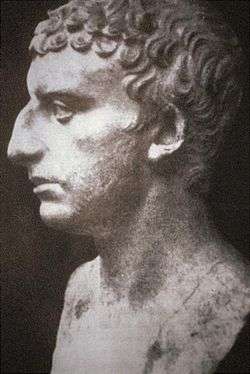
Early nonrabbinic
- Josephus, Antiquities of the Jews book 4, chapter 8, paragraphs 9, 11, 20–21, 23–27, 29, 38–44. Circa 93–94. Reprinted in, e.g., The Works of Josephus: Complete and Unabridged, New Updated Edition. Translated by William Whiston, pages 116–24. Peabody, Massachusetts: Hendrickson Publishers, 1987. ISBN 978-0-913573-86-0.
- Gaius Julius Hyginus. Fabulae 95. 1st–2nd century CE. (reporting the myth of how Odysseus (Ulysses) plowed with ox and horse together to show himself insane).
- Quran 2:275; 3:130. Arabia, 7th century. (Islam’s parallel prohibition of interest, or riba).
Classical rabbinic
- Mishnah: Peah 1:1–8:9; Kilayim 1:1–9:10; Sheviit 10:2; Terumot 8:1; 9:3; Shekalim 1:1; Megillah 3:4; Yevamot 1:1–16:7; Ketubot 3:1–4:1, 3; Nedarim 1:1–11:11; Sotah 6:3; 7:2, 4; 8:4; Gittin 1:1–9:10; Bava Kamma 5:7; 8:1; Bava Metzia 1:1–2:11; 9:11–13; Bava Batra 8:4–5; Sanhedrin 1:1–3; 2:1; 6:4; 7:9; 8:1–7; 11:1; Makkot 3:1–16; Shevuot 1:1–8:6; Chullin 12:1–5; Bekhorot 8:7, 9; Arakhin 3:1, 4–5; Temurah 6:3–4; Parah 2:3; Yadayim 4:4. Land of Israel, circa 200 CE. Reprinted in, e.g., The Mishnah: A New Translation. Translated by Jacob Neusner, pages 14–36, 49–68, 91, 110, 113, 251, 321, 337–78, 381–85, 406–30, 457, 461, 466–87, 515, 520, 528–34, 554–55, 574–75, 583, 585, 595, 599–602, 607, 616–39, 785–807, 812–13, 834, 1014–15, 1129. New Haven: Yale University Press, 1988. ISBN 978-0-300-05022-6.
- Sifre to Deuteronomy 211:1–296:6. Land of Israel, circa 250–350 CE. Reprinted in, e.g., Sifre to Deuteronomy: An Analytical Translation. Translated by Jacob Neusner, volume 2, pages 111–266. Atlanta: Scholars Press, 1987. ISBN 978-1-55540-145-0.
- Tosefta: Berakhot 5:14; Peah 1:1–4:21; Kilayim 1:1–5:27; Maasrot 3:12; Megillah 3:2, 25; Yevamot 1:1–14:10; Ketubot 3:1–4:1; Nedarim 1:1–7:8; Sotah 5:9; 7:20; Gittin 1:1–7:13; Kiddushin 5:4; Bava Kamma 8:10; Bava Metzia 1:1–2:33; 8:7; 10:3, 8, 10–11; Bava Batra 5:7; Sanhedrin 4:1; 7:4; 9:7; Makkot 1:7; 5:14, 17; Shevuot 1:1–6:7; Bekhorot 6:1; Negaim 1:7; 3:2; 6:2; Parah 2:2; Yadayim 2:17. Land of Israel, circa 250 CE. Reprinted in, e.g., The Tosefta: Translated from the Hebrew, with a New Introduction. Translated by Jacob Neusner, volume 1, pages 31, 61, 65, 75, 292, 644, 650, 707, 720, 725, 731, 752, 785–805, 852, 866, 899–901, 920, 943; volume 2, pages 997, 1023–30, 1067, 1084, 1086, 1115, 1155, 1169, 1177, 1201, 1218–44, 1486, 1711, 1717, 1730, 1748, 1908. Peabody, Massachusetts: Hendrickson Publishers, 2002. ISBN 1-56563-642-2.
- Jerusalem Talmud: Berakhot 54b, 59b; Peah 1a–73b; Demai 14a; Kilayim 1a–84b; Terumot 2a, 8a, 12a, 32a, 62a–63b; Maasrot 19a–20a; Challah 8b, 16a; Orlah 20a; Bikkurim 6b; Shabbat 24a, 79a, 86a; Eruvin 35a; Pesachim 13b; Yoma 41b, 53b; Rosh Hashanah 3b, 5b; Moed Katan 14a; Chagigah 1b, 10b; Yevamot 1a–88b; Ketubot 16b, 17b–18b, 20b–22a, 23b, 24b–25a, 26a–27a, 28a, 29a, 30a; Nedarim 1a–42b; Nazir 21a, 29a, 36a–b, 38a; Sotah 1a–b, 6b–7a, 10a, 11b, 12b–13a, 19b–20a, 28b, 30a, 32a, 41b–42a, 43a, 45a; Gittin 1a–53b; Kiddushin 1a–b, 2b, 4b, 5b, 11a, 16b, 21b–22a; Bava Kamma 22b, 27a, 31a; Bava Metzia 6a, 7a–8a, 26b–27a, 32b–33b; Sanhedrin 22a–23a, 35b, 36b; Shevuot 1a–. Tiberias, Land of Israel, circa 400 CE. Reprinted in, e.g., Talmud Yerushalmi. Edited by Chaim Malinowitz, Yisroel Simcha Schorr, and Mordechai Marcus, volumes 2–5, 7–9, 11–13, 15, 17–18, 21, 24, 27–31, 33–35, 37–42. Brooklyn: Mesorah Publications, 2006–2018. And reprinted in, e.g., The Jerusalem Talmud: A Translation and Commentary. Edited by Jacob Neusner and translated by Jacob Neusner, Tzvee Zahavy, B. Barry Levy, and Edward Goldman. Peabody, Massachusetts: Hendrickson Publishers, 2009. ISBN 978-1-59856-528-7.
- Genesis Rabbah 17:7; 19:12; 20:7; 41:3; 43:9; 45:6; 48:16; 52:2, 5; 55:3; 61:7; 63:12; 65:2; 74:7, 15; 76:6; 81:2; 84:16; 85:5; 87:5; 94:9; 99:2. Land of Israel, 5th century. Reprinted in, e.g., Midrash Rabbah: Genesis. Translated by Harry Freedman and Maurice Simon, volume 1, pages 137–38, 157–58, 165–66, 334–35, 358–59, 384, 416, 451, 453, 483; volume 2, pages 545–46, 567, 581, 680, 686–87, 705–06, 745–46, 781–82, 792, 808, 879, 975. London: Soncino Press, 1939. ISBN 0-900689-38-2.
- Leviticus Rabbah 24:7. Land of Israel, 5th century. Reprinted in, e.g., Midrash Rabbah: Leviticus. Translated by Harry Freedman and Maurice Simon, volume 4, pages 309–10. London: Soncino Press, 1939. ISBN 978-0-900689-38-3.
.jpg)
- Babylonian Talmud: Berakhot 7a, 19b, 21b–22a, 25a–b, 28a, 33b, 35a, 55b, 63b; Shabbat 15a, 23a, 25b, 27a, 29b, 32a, 50b, 54a, 56a, 66a, 132b–33a, 136a, 139a, 144b, 150a; Eruvin 13b, 15b; Pesachim 3a, 25a–b, 26b, 31b, 41b, 68a, 72b, 90a, 98a, 116b; Yoma 13b, 36a, 67b, 74b, 81a, 82a; Sukkah 9a, 24b, 29a; Beitzah 3b, 8b, 14b, 19b, 24b, 36b; Rosh Hashanah 4a, 5b–6b; Taanit 6b; Megillah 3b, 6b–7b, 8a, 18a, 25a, 29a; Moed Katan 2a–b, 4b, 8b, 9b, 14b, 18b, 21a, 25b; Chagigah 2b, 3b–4a, 15a, 16b; Yevamot 2a–122b; Ketubot 2b, 5a, 6b, 7b, 9a, 10a–11b, 22a, 29a–41b, 42b–43a, 44a–47a, 48b–49a, 51b, 53b–54a, 66a, 72a, 74a, 77a–b, 80a, 82a–b; Nedarim 2a–91b; Nazir 2a, 23b, 30b, 37a, 41b, 58a, 59a, 66a; Sotah 2b, 3b, 5b, 9a, 16a, 18b, 20b–21b, 23a–25a, 26b, 31b, 33a, 35b, 43a–45a; Gittin 2a–90b; Kiddushin 2a–b, 3b–5a, 6a, 7a, 8b, 9a–10a, 11b, 13b–14a, 21b, 23a, 24b, 29b, 33b–34a, 40a, 41a, 44a, 51a, 56b, 63a–64a, 65b, 67a–69a, 70a, 72b, 74a, 75a, 76a–77a, 78a–b; Bava Kamma 4b–5a, 8a, 15b, 25a, 27a, 28a–b, 38b, 42a, 43a, 46a, 51a, 54a–b, 57a, 65b, 70b, 80b, 81b–82a, 83b–84a, 86b–87a, 88a, 92b, 100a, 110b, 113b; Bava Metzia 2a–33b, 48a, 54a, 56b, 60b–61a, 66a, 70b, 75b, 82a, 87b, 88b–89a, 90a, 91a–92a, 102a, 110b–11b, 113a, 114a–15a; Bava Batra 2b, 11a, 12b, 16b, 19b, 21b, 36a, 45b, 55a, 72b, 74a, 82b, 88b–89a, 108b, 110b, 111b, 113b, 116b, 119b, 122b–23a, 124a–b, 126b–27b, 130a–b, 134a, 142b, 144b, 155b–56a, 168a, 175b; Sanhedrin 2a, 7b, 8b–9a, 10a, 18a–19a, 21a, 27b–28a, 31b, 33b, 34b, 35b, 36b, 41a, 44a, 45a–47b, 49a–50b, 51b, 53a, 54b, 56b–57a, 59b, 65b, 66b, 68b–75a, 82a, 85b–86a, 103b, 105b–06a, 107a; Makkot 2a–b, 4b–5b, 8b, 10b, 13a–24b; Shevuot 2a–49b; Avodah Zarah 17a, 20a, 26b, 37a, 46b, 54a, 62b; Horayot 10b, 12b; Zevachim 2a, 4b, 7b, 18b, 24b, 27b, 29a, 72a, 88a; Menachot 2a, 5b–6a, 10a, 15b, 32a–b, 39a–41a, 43a–44a, 50a, 58a–b, 69b, 90b, 101a, 103a; Chullin 2a, 11a, 26b, 48a, 62b, 68a, 74b, 78b, 83b, 87a, 109b, 115a–16a, 120a–b, 130b–31b, 136a–b, 138b–42a; Bekhorot 13a, 17a, 19b, 46a–b, 47b, 49b, 52a–b, 56a–57a; Arakhin 3b, 6a, 7a, 13b, 14b–15a, 19b, 25b; Temurah 4b–5a, 6a, 29b–30b, 33b; Keritot 2a, 3a, 14b–15a, 17b, 21a–b; Meilah 13a, 18a; Niddah 23b, 26a, 32a, 43a, 44a–b, 49b, 50b–51a, 52a, 55b, 61b, 69b–70a. Babylonia, 6th century. Reprinted in, e.g., Talmud Bavli. Edited by Yisroel Simcha Schorr, Chaim Malinowitz, and Mordechai Marcus, 72 volumes. Brooklyn: Mesorah Pubs., 2006.
Medieval
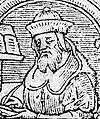
- Deuteronomy Rabbah 6:1–14. Land of Israel, 9th century. Reprinted in, e.g., Midrash Rabbah: Leviticus. Translated by Harry Freedman and Maurice Simon. London: Soncino Press, 1939. ISBN 978-0-900689-38-3.
- Rashi. Commentary. Deuteronomy 21–25. Troyes, France, late 11th century. Reprinted in, e.g., Rashi. The Torah: With Rashi’s Commentary Translated, Annotated, and Elucidated. Translated and annotated by Yisrael Isser Zvi Herczeg, volume 5, pages 221–65. Brooklyn: Mesorah Publications, 1997. ISBN 978-0-89906-030-9.
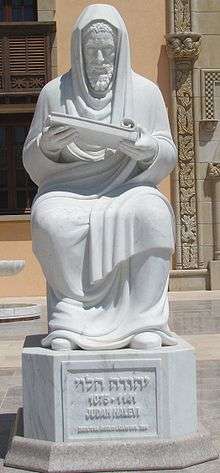
- Rashbam. Commentary on the Torah. Troyes, early 12th century. Reprinted in, e.g., Rashbam’s Commentary on Deuteronomy: An Annotated Translation. Edited and translated by Martin I. Lockshin, pages 129–45. Providence, Rhode Island: Brown Judaic Studies, 2004. ISBN 1-930675-19-4.
- Judah Halevi. Kuzari. 2:58; 3:35. Toledo, Spain, 1130–1140. Reprinted in, e.g., Jehuda Halevi. Kuzari: An Argument for the Faith of Israel. Introduction by Henry Slonimsky, pages 119, 168. New York: Schocken, 1964. ISBN 978-0-8052-0075-1.
- Second Council of the Lateran. Rome, 1139. (usury forbidden).
- Abraham ibn Ezra. Commentary on the Torah. Mid-12th century. Reprinted in, e.g., Ibn Ezra's Commentary on the Pentateuch: Deuteronomy (Devarim). Translated and annotated by H. Norman Strickman and Arthur M. Silver, volume 5, pages 143–87. New York: Menorah Publishing Company, 2001. ISBN 0-932232-10-8.
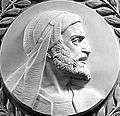
- Maimonides. Mishneh Torah: Hilchot Gezelah Va'Avedah (The Laws of Robery and Lost Property), chapter 11; Hilchot Rotze’ach USh’mirat Nefesh (The Laws of Murder and the Protection of Human Life), chapter 13. Egypt, circa 1170–1180. Reprinted in, e.g., Mishneh Torah: Sefer Nezikin: The Book of Damages. Translated by Eliyahu Touger, pages 330–43, 596–607. New York: Moznaim Publishing, 1997. ISBN 1-885220-18-9.
- Maimonides. Mishneh Torah: Hilchot Malveh V’Loveh (The Laws Pertaining to Lenders and Borrowers), chapter 3, halachah 1. Reprinted in, e.g., Mishneh Torah: Sefer Mishpatim: The Book of Judgments. Translated by Eliyahu Touger, pages 224–27. New York: Moznaim Publishing, 2000. ISBN 1-885220-26-X.
- Maimonides. The Guide for the Perplexed, part 3, chapter 42. Cairo, Egypt, 1190. Reprinted in, e.g., Moses Maimonides. The Guide for the Perplexed. Translated by Michael Friedländer, pages 351–52. New York: Dover Publications, 1956. ISBN 0-486-20351-4.
- Hezekiah ben Manoah. Hizkuni. France, circa 1240. Reprinted in, e.g., Chizkiyahu ben Manoach. Chizkuni: Torah Commentary. Translated and annotated by Eliyahu Munk, volume 4, pages 1147–77. Jerusalem: Ktav Publishers, 2013. ISBN 978-1-60280-261-2.
- Midrash ha-Ne'lam (The Midrash of the Concealed). Spain, 13th century. Reprinted in Zohar Chadash, pages 59a–c. Salonika, 1587. Reprinted in, e.g., The Zohar: Pritzker Edition. Translation and commentary by Nathan Wolski, volume 10, pages 525–37. Stanford, California: Stanford University Press, 2016. ISBN 978-0-8047-8804-5.

- Nachmanides. Commentary on the Torah. Jerusalem, circa 1270. Reprinted in, e.g., Ramban (Nachmanides): Commentary on the Torah: Deuteronomy. Translated by Charles B. Chavel, volume 5, pages 247–306. New York: Shilo Publishing House, 1976. ISBN 0-88328-010-8.
- Dante Alighieri. Inferno. Cantos XI, []. Italy, early 14th century. (usurer’s demise).
- Bahya ben Asher. Commentary on the Torah. Spain, early 14th century. Reprinted in, e.g., Midrash Rabbeinu Bachya: Torah Commentary by Rabbi Bachya ben Asher. Translated and annotated by Eliyahu Munk, volume 7, pages 2610–78. Jerusalem: Lambda Publishers, 2003. ISBN 965-7108-45-4.
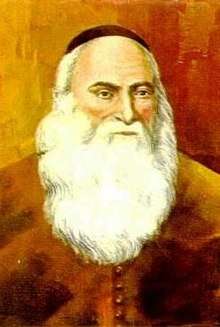
- Isaac ben Moses Arama. Akedat Yizhak (The Binding of Isaac). Late 15th century. Reprinted in, e.g., Yitzchak Arama. Akeydat Yitzchak: Commentary of Rabbi Yitzchak Arama on the Torah. Translated and condensed by Eliyahu Munk, volume 2, pages 864–81. New York, Lambda Publishers, 2001. ISBN 965-7108-30-6.
Modern
.jpg)
- Isaac Abravanel. Commentary on the Torah. Italy, between 1492–1509. Reprinted in, e.g., Abarbanel: Selected Commentaries on the Torah: Volume 5: Devarim/Deuteronomy. Translated and annotated by Israel Lazar, pages 107–28. Brooklyn: CreateSpace, 2015. ISBN 978-1508721659.
- Martin Luther. Long Sermon on Usury. Germany, 1520.
- Martin Luther. On Trade and Usury. Germany, 1524.
- Obadiah ben Jacob Sforno. Commentary on the Torah. Venice, 1567. Reprinted in, e.g., Sforno: Commentary on the Torah. Translation and explanatory notes by Raphael Pelcovitz, pages 934–53. Brooklyn: Mesorah Publications, 1997. ISBN 0-89906-268-7.
- Moshe Alshich. Commentary on the Torah. Safed, circa 1593. Reprinted in, e.g., Moshe Alshich. Midrash of Rabbi Moshe Alshich on the Torah. Translated and annotated by Eliyahu Munk, volume 3, pages 1063–85. New York, Lambda Publishers, 2000. ISBN 965-7108-13-6.
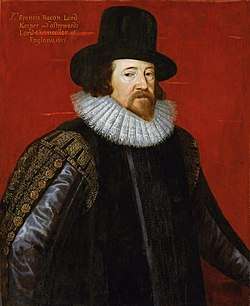
- Francis Bacon. "Of Usury." England, 1612. (Usurers violated the injunction that man live by the sweat of his brow.)
- Avraham Yehoshua Heschel. Commentaries on the Torah. Cracow, Poland, mid 17th century. Compiled as Chanukat HaTorah. Edited by Chanoch Henoch Erzohn. Piotrkow, Poland, 1900. Reprinted in Avraham Yehoshua Heschel. Chanukas HaTorah: Mystical Insights of Rav Avraham Yehoshua Heschel on Chumash. Translated by Avraham Peretz Friedman, pages 308–11. Southfield, Michigan: Targum Press/Feldheim Publishers, 2004. ISBN 1-56871-303-7.
.jpg)
- Thomas Hobbes. Leviathan, Review & Conclusion. England, 1651. Reprint edited by C. B. Macpherson, page 724. Harmondsworth, England: Penguin Classics, 1982. ISBN 978-0-14-043195-7.
- Chaim ibn Attar. Ohr ha-Chaim. Venice, 1742. Reprinted in Chayim ben Attar. Or Hachayim: Commentary on the Torah. Translated by Eliyahu Munk, volume 5, pages 1905–35. Brooklyn: Lambda Publishers, 1999. ISBN 965-7108-12-8.
- Pope Benedict XIV. Vix pervenit: On Usury and Other Dishonest Profit. 1745.
- Moses Mendelssohn. Jerusalem, § 2. Berlin, 1783. Reprinted in Jerusalem: Or on Religious Power and Judaism. Translated by Allan Arkush; introduction and commentary by Alexander Altmann, page 129. Hanover, N.H.: Brandeis Univ. Press, 1983. ISBN 978-0-87451-264-9.
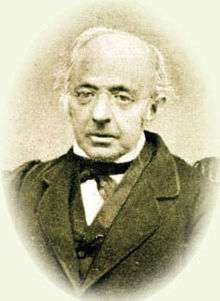
- Jeremy Bentham. Defence of Usury. London, 1787.
- Samuel David Luzzatto (Shadal). Commentary on the Torah. Padua, 1871. Reprinted in, e.g., Samuel David Luzzatto. Torah Commentary. Translated and annotated by Eliyahu Munk, volume 4, pages 1222–46. New York: Lambda Publishers, 2012. ISBN 965-524-067-3.

- Yehudah Aryeh Leib Alter. Sefat Emet. Góra Kalwaria (Ger), Poland, before 1906. Excerpted in The Language of Truth: The Torah Commentary of Sefat Emet. Translated and interpreted by Arthur Green, pages 315–21. Philadelphia: Jewish Publication Society, 1998. ISBN 0-8276-0650-8. Reprinted 2012. ISBN 0-8276-0946-9.
- Hermann Cohen. Religion of Reason: Out of the Sources of Judaism. Translated with an introduction by Simon Kaplan; introductory essays by Leo Strauss, pages 53, 120, 125, 151–52, 154, 431. New York: Ungar, 1972. Reprinted Atlanta: Scholars Press, 1995. ISBN 0-7885-0102-X. Originally published as Religion der Vernunft aus den Quellen des Judentums. Leipzig: Gustav Fock, 1919.
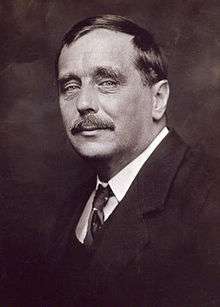
- Abraham Isaac Kook. The Lights of Penitence, 14:33. 1925. Reprinted in Abraham Isaac Kook: the Lights of Penitence, the Moral Principles, Lights of Holiness, Essays, Letters, and Poems. Translated by Ben Zion Bokser, page 108. Mahwah, N.J.: Paulist Press 1978. ISBN 978-0-8091-2159-5.
- H. G. Wells. “Serfs, Slaves, Social Classes and Free Individuals.” In The Outline of History: Being a Plain History of Life and Mankind, pages 254–59. New York: The Macmillan Company, 1920. Revised edition Doubleday and Company, 1971. ISBN 0385024207.
- Alexander Alan Steinbach. Sabbath Queen: Fifty-four Bible Talks to the Young Based on Each Portion of the Pentateuch, pages 155–57. New York: Behrman's Jewish Book House, 1936.
- Joseph Reider. The Holy Scriptures: Deuteronomy with Commentary, pages 198–236. Philadelphia: Jewish Publication Society, 1937.
- Thomas Mann. Joseph and His Brothers. Translated by John E. Woods, pages 55–56, 269–71. New York: Alfred A. Knopf, 2005. ISBN 1-4000-4001-9. Originally published as Joseph und seine Brüder. Stockholm: Bermann-Fischer Verlag, 1943.
- Isaac Mendelsohn. "Slavery in the Ancient Near East." Biblical Archaeologist. Volume 9 (1946): pages 74–88.
- Isaac Mendelsohn. Slavery in the Ancient Near East. New York: Oxford University Press, 1949.
- Morris Adler. The World of the Talmud, pages 26–27, 71. B'nai B'rith Hillel Foundations, 1958. Reprinted Kessinger Publishing, 2007. ISBN 978-0-548-08000-9.
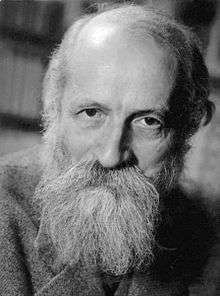
- Martin Buber. On the Bible: Eighteen studies, pages 80–92. New York: Schocken Books, 1968.
- Thomas Thompson and Dorothy Thompson. “Some Legal Problems in the Book of Ruth.” Vetus Testamentum, volume 18 (number 1) (January 1968): pages 79–99. (discussing issues related to Levirate marriage in Deuteronomy 25).
- John R. Bartlett. “The Brotherhood of Edom.” Journal for the Study of the Old Testament, volume 2 (number 4) (February 1977): pages 2–27. (Deuteronomy 23:8).
- Calum M. Carmichael. “A Ceremonial Crux: Removing a Man's Sandal as a Female Gesture of Contempt.”, Journal of Biblical Literature, volume 96, (number 3) (September 1977): pages 321–36.
- Nehama Leibowitz. Studies in Devarim: Deuteronomy, pages 209–56. Jerusalem: The World Zionist Organization, 1980.
- Pinchas H. Peli. Torah Today: A Renewed Encounter with Scripture, pages 221–24. Washington, D.C.: B'nai B'rith Books, 1987. ISBN 0-910250-12-X.
- Ben Zion Bergman. "A Question of Great Interest: May a Synagogue Issue Interest-Bearing Bonds?" New York: Rabbinical Assembly, 1988. YD 167:1.1988a. Reprinted in Responsa: 1980–1990: The Committee on Jewish Law and Standards of the Conservative Movement. Edited by David J. Fine, pages 319–23. New York: Rabbinical Assembly, 2005. ISBN 978-0-916219-27-7.
- Avram Israel Reisner. "Dissent: A Matter of Great Interest" New York: Rabbinical Assembly, 1988. YD 167:1.1988b. Reprinted in Responsa: 1980–1990: The Committee on Jewish Law and Standards of the Conservative Movement. Edited by David J. Fine, pages 324–28. New York: Rabbinical Assembly, 2005. ISBN 978-0-916219-27-7.
- Mark S. Smith. The Early History of God: Yahweh and the Other Deities in Ancient Israel, pages 2, 28. New York: HarperSanFrancisco, 1990. ISBN 0-06-067416-4. (Deuteronomy 23:18).
- A Song of Power and the Power of Song: Essays on the Book of Deuteronomy. Edited by Duane L. Christensen. Winona Lake, Indiana: Eisenbrauns, 1993. ISBN 0-931464-74-9.
- Aaron Wildavsky. Assimilation versus Separation: Joseph the Administrator and the Politics of Religion in Biblical Israel, pages 3–4. New Brunswick, N.J.: Transaction Publishers, 1993. ISBN 978-1-56000-081-5.
- Judith S. Antonelli. "The Captured Woman." In In the Image of God: A Feminist Commentary on the Torah, pages 455–70. Northvale, New Jersey: Jason Aronson, 1995. ISBN 1-56821-438-3.
- David Frankel. "The Deuteronomic Portrayal of Balaam." Vetus Testamentum, volume 46 (number 1) (January 1996): pages 30–42.
- Ellen Frankel. The Five Books of Miriam: A Woman’s Commentary on the Torah, pages 271–85. New York: G. P. Putnam's Sons, 1996. ISBN 0-399-14195-2.
- Marc Gellman. God’s Mailbox: More Stories About Stories in the Bible, pages 90–98. New York: Morrow Junior Books, 1996. ISBN 978-0-688-13169-2.
- Jack R. Lundbom. "The Inclusio and Other Framing Devices in Deuteronomy I–XXVIII." Vetus Testamentum, volume 46 (number 3) (July 1996): pages 296–315.

- W. Gunther Plaut. The Haftarah Commentary, pages 482–88. New York: UAHC Press, 1996. ISBN 0-8074-0551-5.
- Judith Hauptman. “Divorce” and “Rape and Seduction.” In Rereading The Rabbis: A Woman's Voice, pages 77–129. Boulder, Colorado: Westview Press, 1997. ISBN 0-8133-3400-4.
- Sorel Goldberg Loeb and Barbara Binder Kadden. Teaching Torah: A Treasury of Insights and Activities, pages 322–28. Denver: A.R.E. Publishing, 1997. ISBN 0-86705-041-1.
- Judith Gary Brown. "The Accused Woman." In The Women's Torah Commentary: New Insights from Women Rabbis on the 54 Weekly Torah Portions. Edited by Elyse Goldstein, pages 364–70. Woodstock, Vermont: Jewish Lights Publishing, 2000. ISBN 1-58023-076-8.
- Richard D. Nelson. "Deuteronomy." In The HarperCollins Bible Commentary. Edited by James L. Mays, pages 206–08. New York: HarperCollins Publishers, revised edition, 2000. ISBN 0-06-065548-8.
- Joseph Telushkin. The Book of Jewish Values: A Day-by-Day Guide to Ethical Living, pages 4–6. New York: Bell Tower, 2000. ISBN 978-0-609-60330-7.
- Walter Brueggemann. Abingdon Old Testament Commentaries: Deuteronomy, pages 207–45. Nashville: Abingdon Press, 2001. ISBN 0-687-08471-7.
- Timothy M. Willis. The Elders of the City: A Study of the Elders-Laws in Deuteronomy. Atlanta: Society of Biblical Literature, 2001. ISBN 1-58983-013-X.
- Lainie Blum Cogan and Judy Weiss. Teaching Haftarah: Background, Insights, and Strategies, pages 324–26. Denver: A.R.E. Publishing, 2002. ISBN 0-86705-054-3.
- Michael Fishbane. The JPS Bible Commentary: Haftarot, pages 301–04. Philadelphia: Jewish Publication Society, 2002. ISBN 0-8276-0691-5.
- Alan Lew. This Is Real and You Are Completely Unprepared: The Days of Awe as a Journey of Transformation, pages 65, 85–92. Boston: Little, Brown and Co., 2003. ISBN 978-0-316-73908-5.
- Joseph Telushkin. The Ten Commandments of Character: Essential Advice for Living an Honorable, Ethical, Honest Life, pages 94–97. New York: Bell Tower, 2003. ISBN 1-4000-4509-6.
- Robert Alter. The Five Books of Moses: A Translation with Commentary, pages 981–1003. New York: W.W. Norton & Co., 2004. ISBN 0-393-01955-1.
- Bernard M. Levinson. "Deuteronomy." In The Jewish Study Bible. Edited by Adele Berlin and Marc Zvi Brettler, pages 414–23. New York: Oxford University Press, 2004. ISBN 0-19-529751-2.
- Professors on the Parashah: Studies on the Weekly Torah Reading Edited by Leib Moscovitz, pages 328–39. Jerusalem: Urim Publications, 2005. ISBN 965-7108-74-8.
- Bruce Wells. "Sex, Lies, and Virginal Rape: The Slandered Bride and False Accusation in Deuteronomy." Journal of Biblical Literature, volume 124 (number 1) (Spring 2005): pages 41–72.
- Judith Z. Abrams. "Misconceptions About Disabilities in the Hebrew Bible." In Jewish Perspectives on Theology and the Human Experience of Disability. Edited by Judith Z. Abrams & William C. Gaventa, pages 81–82. Binghamton, N.Y.: Haworth Pastoral Press, 2006. ISBN 978-0-7890-3444-1.
- Marc Cortez. “The Law on Violent Intervention: Deuteronomy 25.11–12 Revisited.” Journal for the Study of the Old Testament, volume 30 (number 4) (June 2006): pages 431–47.
- W. Gunther Plaut. The Torah: A Modern Commentary: Revised Edition. Revised edition edited by David E.S. Stern, pages 1320–46. New York: Union for Reform Judaism, 2006. ISBN 0-8074-0883-2.
- Suzanne A. Brody. "Tsitsit." In Dancing in the White Spaces: The Yearly Torah Cycle and More Poems, page 107. Shelbyville, Kentucky: Wasteland Press, 2007. ISBN 978-1-60047-112-4.
- James L. Kugel. How To Read the Bible: A Guide to Scripture, Then and Now, pages 64, 140, 175, 236, 261, 270, 278, 309–12, 395, 402–03, 407, 448–49, 579, 610. New York: Free Press, 2007. ISBN 0-7432-3586-X.
- Michael D. Matlock. “Obeying the First Part of the Tenth Commandment: Applications from the Levirate Marriage Law.” Journal for the Study of the Old Testament, volume 31 (number 3) (March 2007): pages 295–310.
- Joseph Fleishman. “The Delinquent Daughter and Legal Innovation in Deuteronomy XXII 20–21.” Vetus Testamentum, volume 58 (number 2) (2008): pages 191–210.
- The Torah: A Women's Commentary. Edited by Tamara Cohn Eskenazi and Andrea L. Weiss, pages 1165–90. New York: URJ Press, 2008. ISBN 0-8074-1081-0.
- Eugene E. Carpenter. "Deuteronomy." In Zondervan Illustrated Bible Backgrounds Commentary. Edited by John H. Walton, volume 1, pages 491–505. Grand Rapids, Michigan: Zondervan, 2009. ISBN 978-0-310-25573-4.
- Reuven Hammer. Entering Torah: Prefaces to the Weekly Torah Portion, pages 281–85. New York: Gefen Publishing House, 2009. ISBN 978-965-229-434-0.
- Elliot Kukla and Reuben Zellman. "To Wear Is Human, to Live — Divine: Parashat Ki Tetse (Deuteronomy 21:10–25:19)." In Torah Queeries: Weekly Commentaries on the Hebrew Bible. Edited by Gregg Drinkwater, Joshua Lesser, and David Shneer; foreword by Judith Plaskow, pages 254–58. New York: New York University Press, 2009. ISBN 0-8147-2012-9.
- Meir Malul. “What is the Nature of the Crime of the Delinquent Daughter in Deuteronomy 22:13–21? A Rejoinder to J. Fleishman's Suggestion.” Vetus Testamentum, volume 59 (number 3) (2009): pages 446–59.
- Dvora E. Weisberg. Levirate Marriage and the Family in Ancient Judaism. Waltham, Massachusetts: Brandeis University Press, 2009. ISBN 978-1-58465-781-1.
- Jerry Z. Muller. "The Long Shadow of Usury." In Capitalism and the Jews, pages 15–71. Princeton: Princeton University Press, 2010. ISBN 978-0-691-14478-8.
- Natan Slifkin. Shiluach haKein: The Transformation of a Mitzvah. Jerusalem: Lander Institute, 2010.
- Marjorie Ingall. "Shatnez Shock: Pondering One of the Torah’s Woolliest Rules." Tablet Magazine. (July 19, 2010).
- Young Hye Kim. “The Jubilee: Its Reckoning and Inception Day.” Vetus Testamentum, volume 60 (number 1) (2010): pages 147–51.
- Bruce Wells. “The Hated Wife in Deuteronomic Law.” Vetus Testamentum, volume 60 (number 1) (2010): pages 131–46.
- William G. Dever. The Lives of Ordinary People in Ancient Israel: When Archaeology and the Bible Intersect, pages 178, 188, 190, 192, 245. Grand Rapids, Michigan: William B. Eerdmans Publishing Company, 2012. ISBN 978-0-8028-6701-8.
- Jonathan Haidt. The Righteous Mind: Why Good People Are Divided by Politics and Religion, pages 13, 325 note 22. New York: Pantheon, 2012. ISBN 978-0-307-37790-6. (clothing made from different fibers).

- Shmuel Herzfeld. "The Torah’s Attitude toward Behavior in War." In Fifty-Four Pick Up: Fifteen-Minute Inspirational Torah Lessons, pages 279–83. Jerusalem: Gefen Publishing House, 2012. ISBN 978-965-229-558-3.
- Stephen Beard. "Britain Wants To Be Hub for Sharia Banking." Marketplace. (July 18, 2013) (adaptation to Islam’s parallel prohibition on charging interest).
- Beth Kissileff. "Accept Responsibility: The refusal to hide ourselves from the needs of others has positive consequences." The Jerusalem Report, volume 24 (number 10) (August 26, 2013): page 45.
- Eve Levavi Feinstein. “Restoration of Marriage (Deut 24:1–4).” In Sexual Pollution in the Hebrew Bible, pages 53–65. New York: Oxford University Press, 2014. ISBN 978-0-19-939556-9.
- Edward Lipinski. "Cult Prostitution in Ancient Israel?" Biblical Archaeology Review, volume 40 (number 1) (January/February 2014): pages 48–56, 70.

- Nicholas Kristof. "When Emily Was Sold for Sex." The New York Times. (February 13, 2014): page A27. (human trafficking in our time).
- Shlomo Riskin. Torah Lights: Devarim: Moses Bequeaths Legacy, History, and Covenant, pages 203–68. New Milford, Connecticut: Maggid Books, 2014. ISBN 978-159-264-276-2.
- Gabriel Sanders. "The Biblical Side of ‘Saving Private Ryan’: Spielberg’s WWII epic alludes to Abraham Lincoln and Abraham the patriarch." Tablet Magazine. (July 1, 2014).
- Walk Free Foundation. The Global Slavery Index 2014. Australia, 2014.
- Pablo Diego-Rosell and Jacqueline Joudo Larsen. "35.8 Million Adults and Children in Slavery Worldwide." Gallup. (November 17, 2014).
- Beverly Siegel. "Sign on the Dotted Line: To fight the chained-wife problem, more women are insisting on a special prenup." Tablet Magazine. (March 6, 2015).
- Peter Kohn. "Court ruling eases Jewish divorce." Australian Jewish News. (March 9, 2015).
- The Commentators' Bible: The Rubin JPS Miqra'ot Gedolot: Deuteronomy. Edited, translated, and annotated by Michael Carasik, pages 142–71. Philadelphia: Jewish Publication Society, 2015. ISBN 978-0-8276-0939-6.
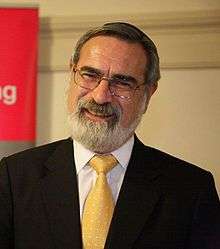
- Jonathan Sacks. Lessons in Leadership: A Weekly Reading of the Jewish Bible, pages 269–73. New Milford, Connecticut: Maggid Books, 2015. ISBN 978-1-59264-432-2.
- Atar Hadari. "For the Torah, Women Aren't Commodities, and Marriage Isn't a Pro-Forma Prelude to Sex: The point of the Torah’s rules on foreign brides and divorce." Mosaic Magazine. (September 15, 2016).
- David Booth, Ashira Konigsburg, and Baruch Frydman-Kohl. “Modesty Inside and Out: A Contemporary Guide to Tzniut,” pages 7, 16. New York: Rabbinical Assembly, 2016. (Deuteronomy 23:13–15 and modesty in dress).
- Donniel Hartman. “You Are Your Brother’s Keeper: The Religious Ethic of Nonindifference.” In Putting God Second: How to Save Religion from Itself, pages 20–31. Boston: Beacon Press, 2016. ISBN 978-0807053928. (implications of Deuteronomy 22:3, “you must not remain indifferent”).
- Jonathan Sacks. Essays on Ethics: A Weekly Reading of the Jewish Bible, pages 305–10. New Milford, Connecticut: Maggid Books, 2016. ISBN 978-1-59264-449-0.
- Shai Held. The Heart of Torah, Volume 2: Essays on the Weekly Torah Portion: Leviticus, Numbers, and Deuteronomy, pages 250–59. Philadelphia: Jewish Publication Society, 2017. ISBN 978-0827612716.
- Jeremy Kalmanofsky. “Alternative Kevura Methods.” New York: Rabbinical Assembly, 2017. (environmentally friendly burial practices as well as alternatives to burial including alkaline hydrolysis and promession in the light of Deuteronomy 21:22–23).
- Steven Levy and Sarah Levy. The JPS Rashi Discussion Torah Commentary, pages 167–70. Philadelphia: Jewish Publication Society, 2017. ISBN 978-0827612693.
- Caryn A. Reeder. “Deuteronomy 21.10–14 and/as Wartime Rape.” Journal for the Study of the Old Testament, volume 41 (number 3) (March 2017): pages 313–36.
- Somini Sengupta. “End Marry-Your-Rapist Laws, Activists Say. Mideast Listens.” The New York Times, July 23, 2017, § 1 (news), page 1 (modern Middle Eastern parallel to Exodus 22:15–16 and Deuteronomy 22:28–29).
- Pekka Pitkänen. “Ancient Israelite Population Economy: Ger, Toshav, Nakhri and Karat as Settler Colonial Categories.” Journal for the Study of the Old Testament, volume 42 (number 2) (December 2017): pages 139–53.
- U.S. Department of State. Trafficking in Persons Report: June 2018. (slavery in the present day).
External links
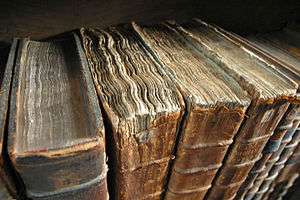
Texts
Commentaries
- Academy for Jewish Religion, New York
- Aish.com
- Akhlah: The Jewish Children’s Learning Network
- Aleph Beta Academy
- American Jewish University — Ziegler School of Rabbinic Studies
- Anshe Emes Synagogue, Los Angeles
- Ari Goldwag
- Ascent of Safed
- Bar-Ilan University
- Chabad.org
- eparsha.com
- G-dcast
- The Israel Koschitzky Virtual Beit Midrash
- Jewish Agency for Israel
- Jewish Theological Seminary
- Kabbala Online
- Mechon Hadar
- MyJewishLearning.com
- Ohr Sameach
- Orthodox Union
- OzTorah, Torah from Australia
- Oz Ve Shalom — Netivot Shalom
- Pardes from Jerusalem
- Professor James L. Kugel
- Professor Michael Carasik
- Rabbi Fabian Werbin
- Rabbi Jonathan Sacks
- Rabbi Shlomo Riskin
- Rabbi Shmuel Herzfeld
- Rabbi Stan Levin
- Reconstructionist Judaism
- Sephardic Institute
- Shiur.com
- 613.org Jewish Torah Audio
- Tanach Study Center
- Teach613.org, Torah Education at Cherry Hill
- TheTorah.com
- Torah from Dixie
- Torah.org
- TorahVort.com
- Union for Reform Judaism
- United Synagogue of Conservative Judaism
- What’s Bothering Rashi?
- Yeshivat Chovevei Torah
- Yeshiva University
